Lindl Case Study: Pre Expansion Analysis
VerifiedAdded on 2022/11/14
|19
|4377
|476
AI Summary
This report aims to analyze the international business structure in terms of expansion. The chosen organization is Lidl, a discount retail chain based in Germany. The organization desires to expand in either Norway or Mexico. For the purpose of external analysis, a comparative study of Norway and Mexico has been executed. The resultant territory for international expansion is Norway where it is suitable over Mexico in all aspects. After choosing Norway, as the country for expansion, VRIO framework is used for internal analysis. Lastly, suitable recommendations are being provided for gaining access into the Norwegian market, which will enable the company to enter the market and gain large market share very quickly.
Contribute Materials
Your contribution can guide someone’s learning journey. Share your
documents today.
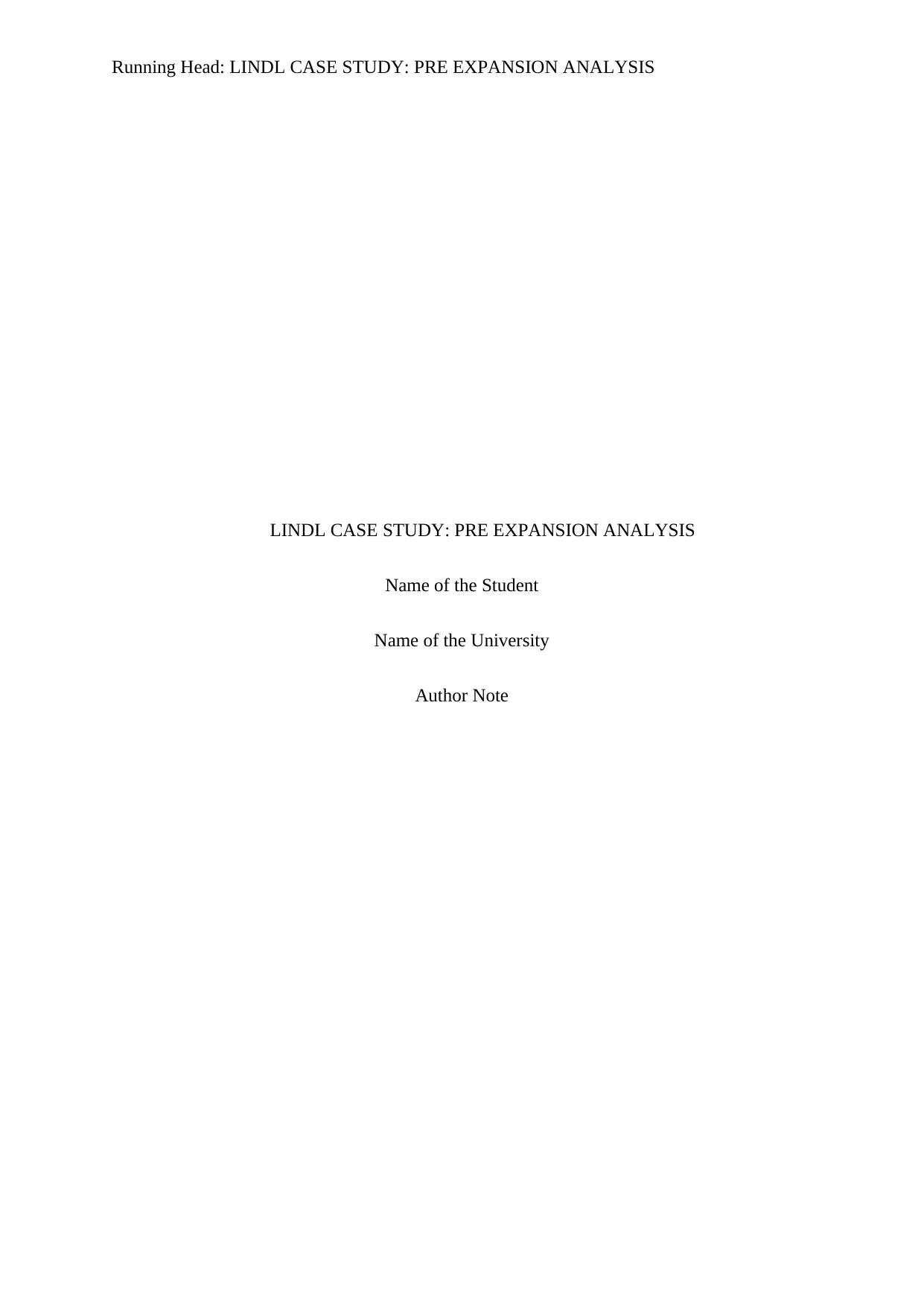
Running Head: LINDL CASE STUDY: PRE EXPANSION ANALYSIS
LINDL CASE STUDY: PRE EXPANSION ANALYSIS
Name of the Student
Name of the University
Author Note
LINDL CASE STUDY: PRE EXPANSION ANALYSIS
Name of the Student
Name of the University
Author Note
Secure Best Marks with AI Grader
Need help grading? Try our AI Grader for instant feedback on your assignments.
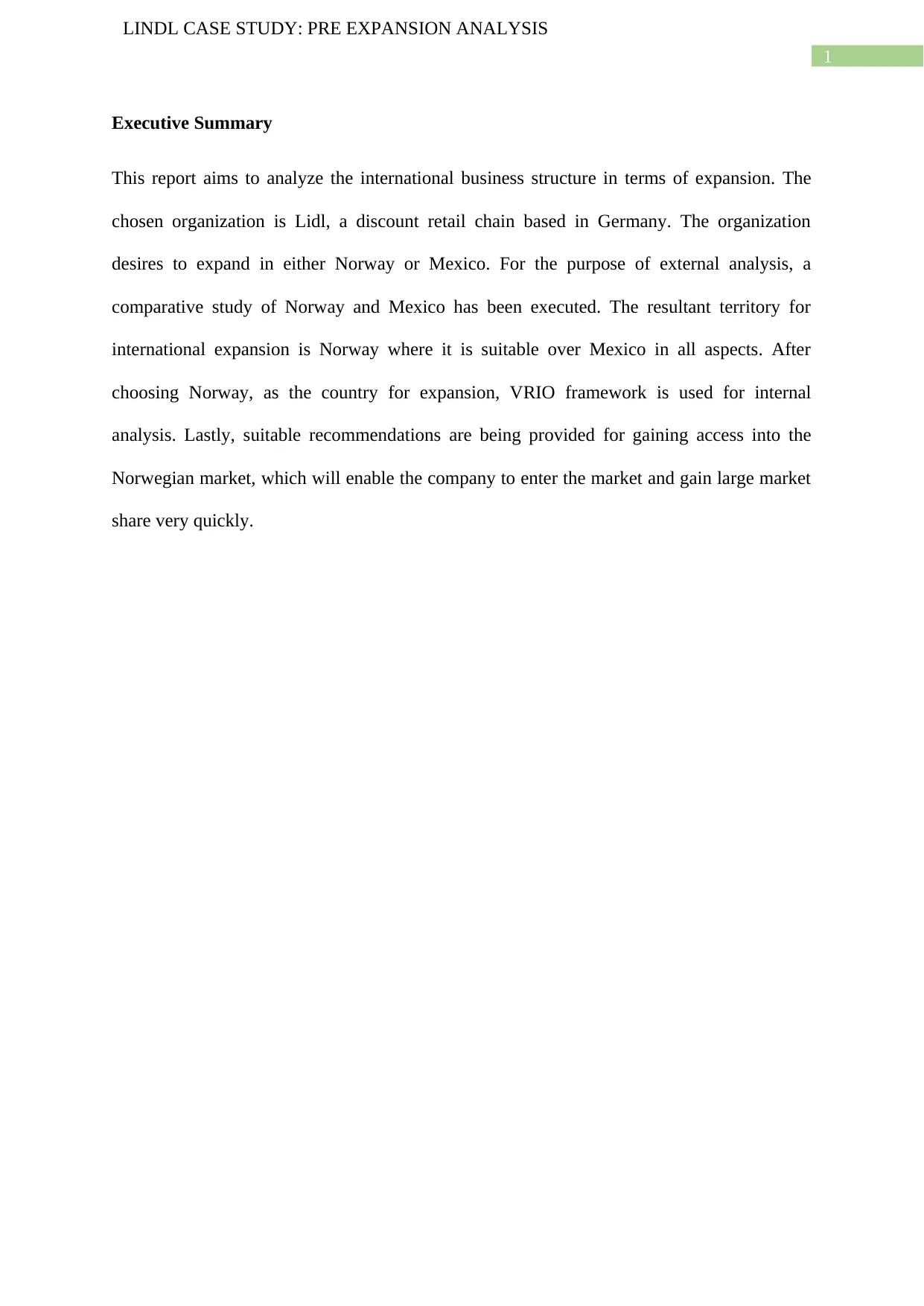
1
LINDL CASE STUDY: PRE EXPANSION ANALYSIS
Executive Summary
This report aims to analyze the international business structure in terms of expansion. The
chosen organization is Lidl, a discount retail chain based in Germany. The organization
desires to expand in either Norway or Mexico. For the purpose of external analysis, a
comparative study of Norway and Mexico has been executed. The resultant territory for
international expansion is Norway where it is suitable over Mexico in all aspects. After
choosing Norway, as the country for expansion, VRIO framework is used for internal
analysis. Lastly, suitable recommendations are being provided for gaining access into the
Norwegian market, which will enable the company to enter the market and gain large market
share very quickly.
LINDL CASE STUDY: PRE EXPANSION ANALYSIS
Executive Summary
This report aims to analyze the international business structure in terms of expansion. The
chosen organization is Lidl, a discount retail chain based in Germany. The organization
desires to expand in either Norway or Mexico. For the purpose of external analysis, a
comparative study of Norway and Mexico has been executed. The resultant territory for
international expansion is Norway where it is suitable over Mexico in all aspects. After
choosing Norway, as the country for expansion, VRIO framework is used for internal
analysis. Lastly, suitable recommendations are being provided for gaining access into the
Norwegian market, which will enable the company to enter the market and gain large market
share very quickly.
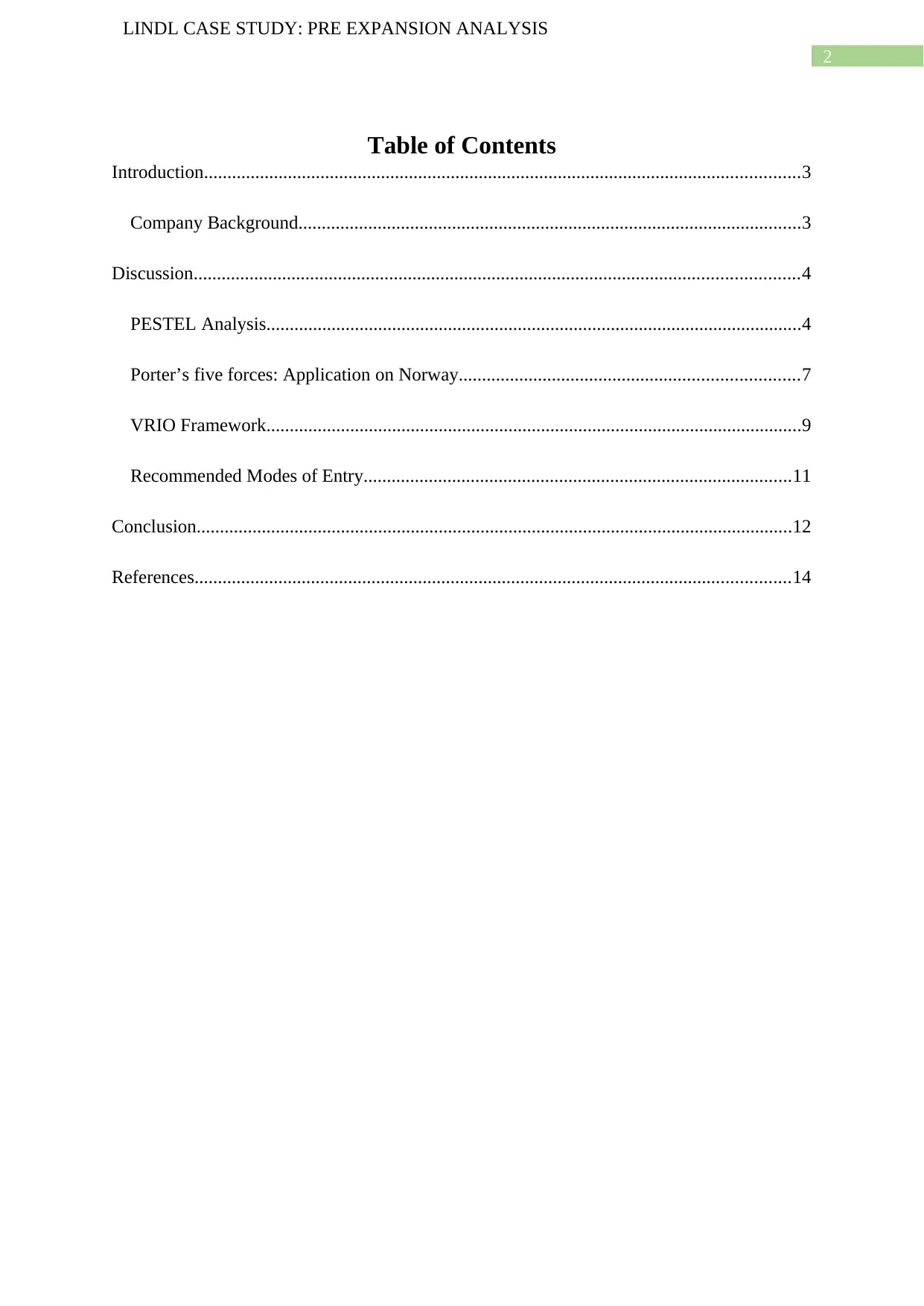
2
LINDL CASE STUDY: PRE EXPANSION ANALYSIS
Table of Contents
Introduction................................................................................................................................3
Company Background............................................................................................................3
Discussion..................................................................................................................................4
PESTEL Analysis...................................................................................................................4
Porter’s five forces: Application on Norway.........................................................................7
VRIO Framework...................................................................................................................9
Recommended Modes of Entry............................................................................................11
Conclusion................................................................................................................................12
References................................................................................................................................14
LINDL CASE STUDY: PRE EXPANSION ANALYSIS
Table of Contents
Introduction................................................................................................................................3
Company Background............................................................................................................3
Discussion..................................................................................................................................4
PESTEL Analysis...................................................................................................................4
Porter’s five forces: Application on Norway.........................................................................7
VRIO Framework...................................................................................................................9
Recommended Modes of Entry............................................................................................11
Conclusion................................................................................................................................12
References................................................................................................................................14
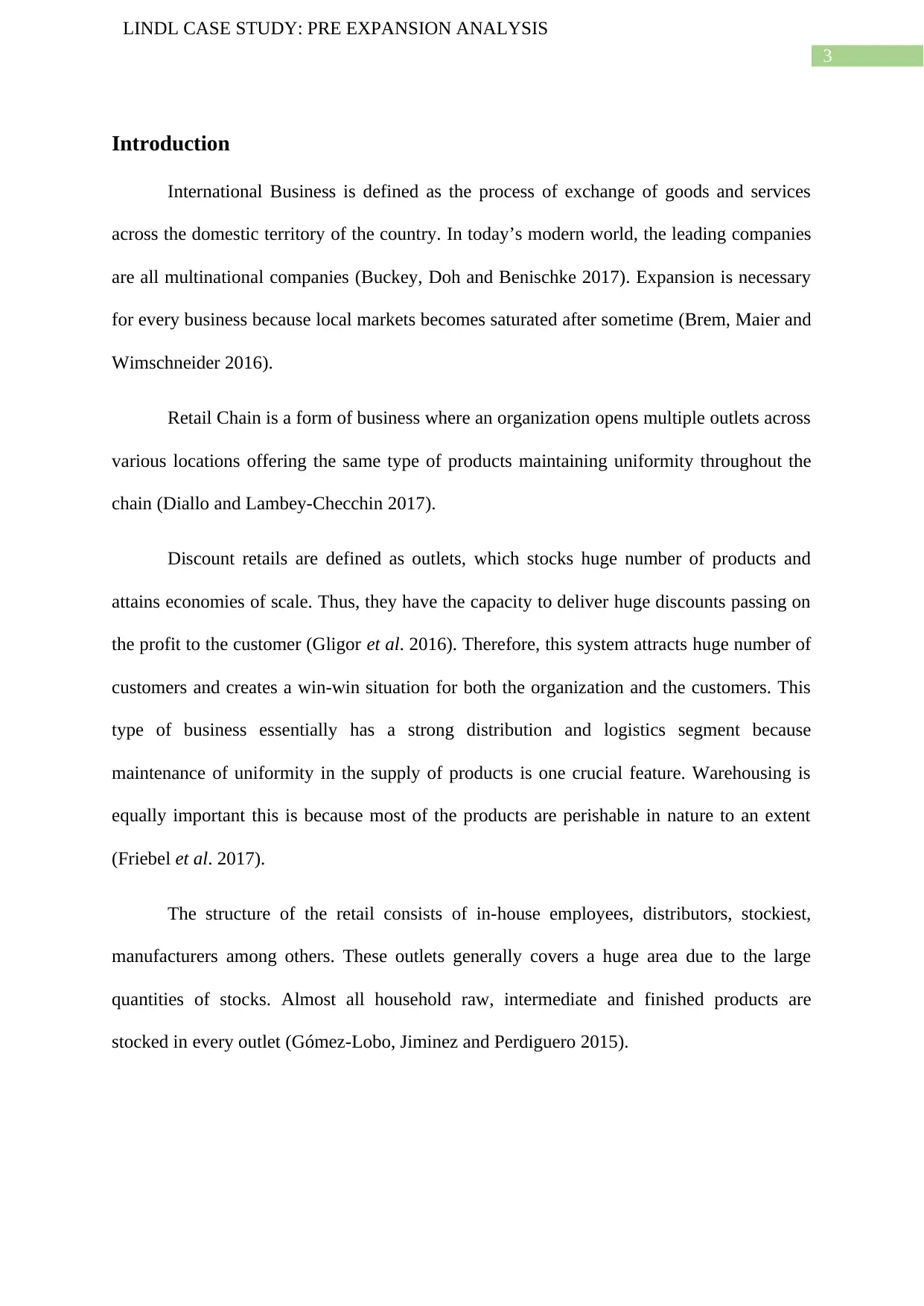
3
LINDL CASE STUDY: PRE EXPANSION ANALYSIS
Introduction
International Business is defined as the process of exchange of goods and services
across the domestic territory of the country. In today’s modern world, the leading companies
are all multinational companies (Buckey, Doh and Benischke 2017). Expansion is necessary
for every business because local markets becomes saturated after sometime (Brem, Maier and
Wimschneider 2016).
Retail Chain is a form of business where an organization opens multiple outlets across
various locations offering the same type of products maintaining uniformity throughout the
chain (Diallo and Lambey-Checchin 2017).
Discount retails are defined as outlets, which stocks huge number of products and
attains economies of scale. Thus, they have the capacity to deliver huge discounts passing on
the profit to the customer (Gligor et al. 2016). Therefore, this system attracts huge number of
customers and creates a win-win situation for both the organization and the customers. This
type of business essentially has a strong distribution and logistics segment because
maintenance of uniformity in the supply of products is one crucial feature. Warehousing is
equally important this is because most of the products are perishable in nature to an extent
(Friebel et al. 2017).
The structure of the retail consists of in-house employees, distributors, stockiest,
manufacturers among others. These outlets generally covers a huge area due to the large
quantities of stocks. Almost all household raw, intermediate and finished products are
stocked in every outlet (Gómez-Lobo, Jiminez and Perdiguero 2015).
LINDL CASE STUDY: PRE EXPANSION ANALYSIS
Introduction
International Business is defined as the process of exchange of goods and services
across the domestic territory of the country. In today’s modern world, the leading companies
are all multinational companies (Buckey, Doh and Benischke 2017). Expansion is necessary
for every business because local markets becomes saturated after sometime (Brem, Maier and
Wimschneider 2016).
Retail Chain is a form of business where an organization opens multiple outlets across
various locations offering the same type of products maintaining uniformity throughout the
chain (Diallo and Lambey-Checchin 2017).
Discount retails are defined as outlets, which stocks huge number of products and
attains economies of scale. Thus, they have the capacity to deliver huge discounts passing on
the profit to the customer (Gligor et al. 2016). Therefore, this system attracts huge number of
customers and creates a win-win situation for both the organization and the customers. This
type of business essentially has a strong distribution and logistics segment because
maintenance of uniformity in the supply of products is one crucial feature. Warehousing is
equally important this is because most of the products are perishable in nature to an extent
(Friebel et al. 2017).
The structure of the retail consists of in-house employees, distributors, stockiest,
manufacturers among others. These outlets generally covers a huge area due to the large
quantities of stocks. Almost all household raw, intermediate and finished products are
stocked in every outlet (Gómez-Lobo, Jiminez and Perdiguero 2015).
Secure Best Marks with AI Grader
Need help grading? Try our AI Grader for instant feedback on your assignments.
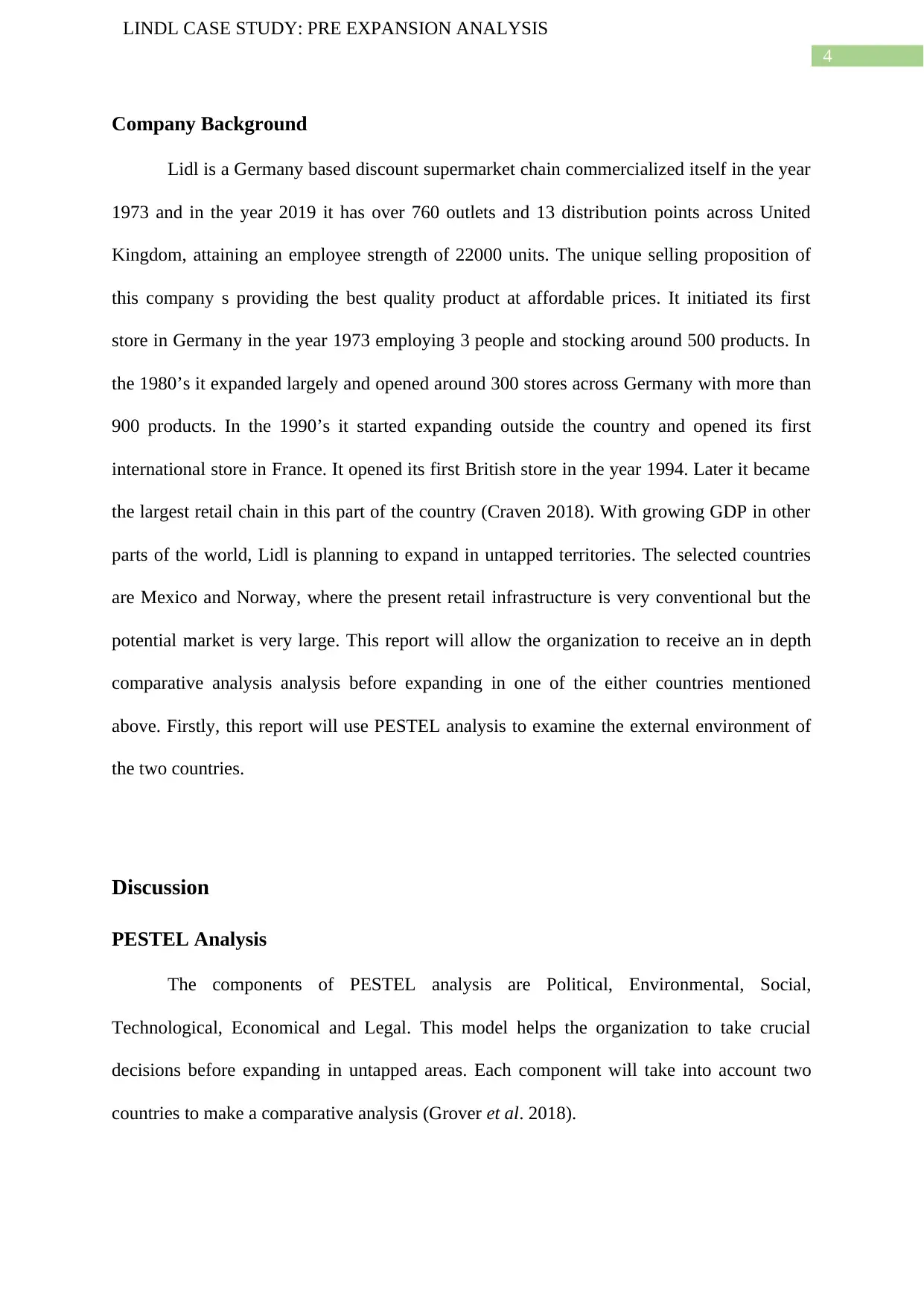
4
LINDL CASE STUDY: PRE EXPANSION ANALYSIS
Company Background
Lidl is a Germany based discount supermarket chain commercialized itself in the year
1973 and in the year 2019 it has over 760 outlets and 13 distribution points across United
Kingdom, attaining an employee strength of 22000 units. The unique selling proposition of
this company s providing the best quality product at affordable prices. It initiated its first
store in Germany in the year 1973 employing 3 people and stocking around 500 products. In
the 1980’s it expanded largely and opened around 300 stores across Germany with more than
900 products. In the 1990’s it started expanding outside the country and opened its first
international store in France. It opened its first British store in the year 1994. Later it became
the largest retail chain in this part of the country (Craven 2018). With growing GDP in other
parts of the world, Lidl is planning to expand in untapped territories. The selected countries
are Mexico and Norway, where the present retail infrastructure is very conventional but the
potential market is very large. This report will allow the organization to receive an in depth
comparative analysis analysis before expanding in one of the either countries mentioned
above. Firstly, this report will use PESTEL analysis to examine the external environment of
the two countries.
Discussion
PESTEL Analysis
The components of PESTEL analysis are Political, Environmental, Social,
Technological, Economical and Legal. This model helps the organization to take crucial
decisions before expanding in untapped areas. Each component will take into account two
countries to make a comparative analysis (Grover et al. 2018).
LINDL CASE STUDY: PRE EXPANSION ANALYSIS
Company Background
Lidl is a Germany based discount supermarket chain commercialized itself in the year
1973 and in the year 2019 it has over 760 outlets and 13 distribution points across United
Kingdom, attaining an employee strength of 22000 units. The unique selling proposition of
this company s providing the best quality product at affordable prices. It initiated its first
store in Germany in the year 1973 employing 3 people and stocking around 500 products. In
the 1980’s it expanded largely and opened around 300 stores across Germany with more than
900 products. In the 1990’s it started expanding outside the country and opened its first
international store in France. It opened its first British store in the year 1994. Later it became
the largest retail chain in this part of the country (Craven 2018). With growing GDP in other
parts of the world, Lidl is planning to expand in untapped territories. The selected countries
are Mexico and Norway, where the present retail infrastructure is very conventional but the
potential market is very large. This report will allow the organization to receive an in depth
comparative analysis analysis before expanding in one of the either countries mentioned
above. Firstly, this report will use PESTEL analysis to examine the external environment of
the two countries.
Discussion
PESTEL Analysis
The components of PESTEL analysis are Political, Environmental, Social,
Technological, Economical and Legal. This model helps the organization to take crucial
decisions before expanding in untapped areas. Each component will take into account two
countries to make a comparative analysis (Grover et al. 2018).
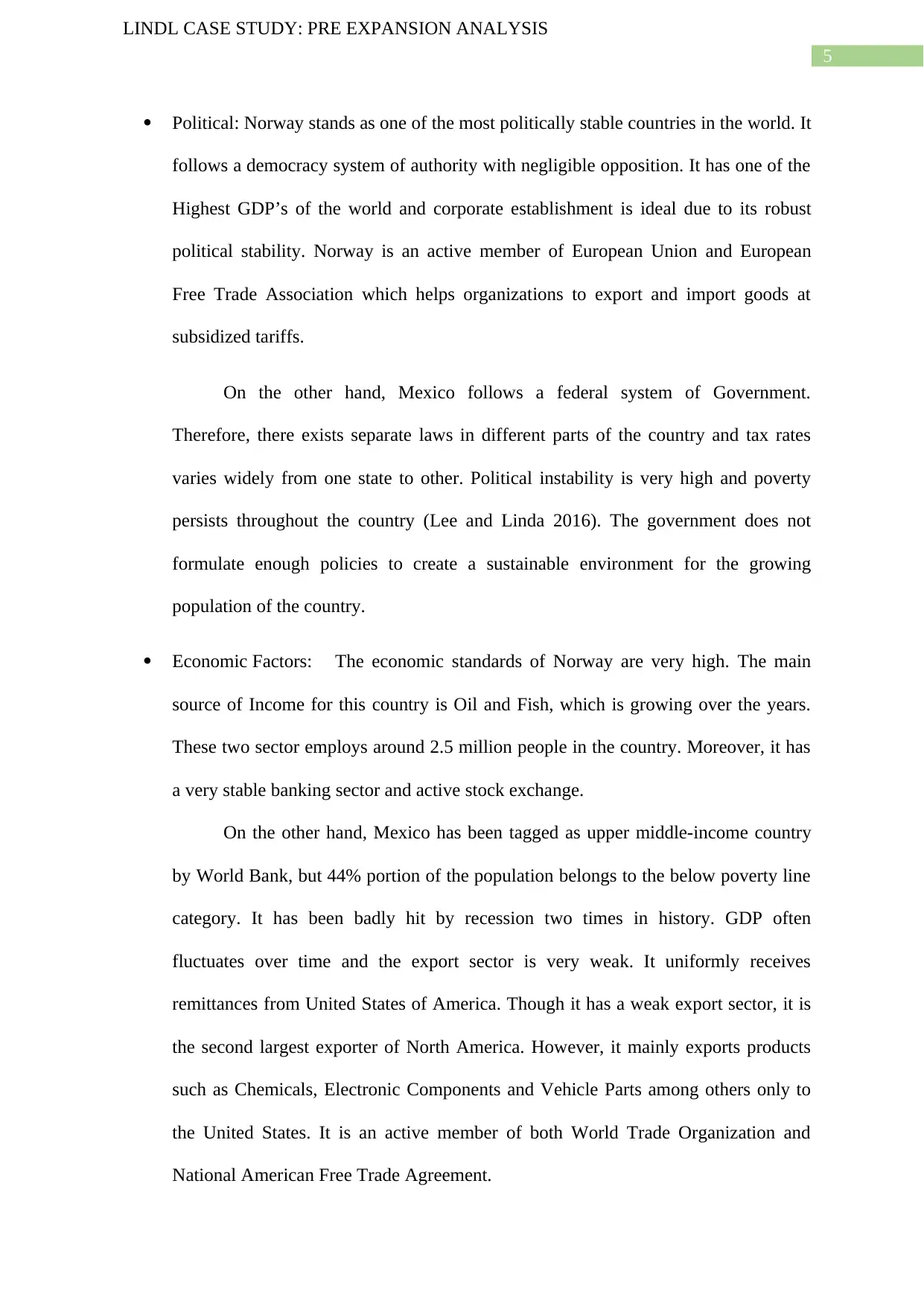
5
LINDL CASE STUDY: PRE EXPANSION ANALYSIS
Political: Norway stands as one of the most politically stable countries in the world. It
follows a democracy system of authority with negligible opposition. It has one of the
Highest GDP’s of the world and corporate establishment is ideal due to its robust
political stability. Norway is an active member of European Union and European
Free Trade Association which helps organizations to export and import goods at
subsidized tariffs.
On the other hand, Mexico follows a federal system of Government.
Therefore, there exists separate laws in different parts of the country and tax rates
varies widely from one state to other. Political instability is very high and poverty
persists throughout the country (Lee and Linda 2016). The government does not
formulate enough policies to create a sustainable environment for the growing
population of the country.
Economic Factors: The economic standards of Norway are very high. The main
source of Income for this country is Oil and Fish, which is growing over the years.
These two sector employs around 2.5 million people in the country. Moreover, it has
a very stable banking sector and active stock exchange.
On the other hand, Mexico has been tagged as upper middle-income country
by World Bank, but 44% portion of the population belongs to the below poverty line
category. It has been badly hit by recession two times in history. GDP often
fluctuates over time and the export sector is very weak. It uniformly receives
remittances from United States of America. Though it has a weak export sector, it is
the second largest exporter of North America. However, it mainly exports products
such as Chemicals, Electronic Components and Vehicle Parts among others only to
the United States. It is an active member of both World Trade Organization and
National American Free Trade Agreement.
LINDL CASE STUDY: PRE EXPANSION ANALYSIS
Political: Norway stands as one of the most politically stable countries in the world. It
follows a democracy system of authority with negligible opposition. It has one of the
Highest GDP’s of the world and corporate establishment is ideal due to its robust
political stability. Norway is an active member of European Union and European
Free Trade Association which helps organizations to export and import goods at
subsidized tariffs.
On the other hand, Mexico follows a federal system of Government.
Therefore, there exists separate laws in different parts of the country and tax rates
varies widely from one state to other. Political instability is very high and poverty
persists throughout the country (Lee and Linda 2016). The government does not
formulate enough policies to create a sustainable environment for the growing
population of the country.
Economic Factors: The economic standards of Norway are very high. The main
source of Income for this country is Oil and Fish, which is growing over the years.
These two sector employs around 2.5 million people in the country. Moreover, it has
a very stable banking sector and active stock exchange.
On the other hand, Mexico has been tagged as upper middle-income country
by World Bank, but 44% portion of the population belongs to the below poverty line
category. It has been badly hit by recession two times in history. GDP often
fluctuates over time and the export sector is very weak. It uniformly receives
remittances from United States of America. Though it has a weak export sector, it is
the second largest exporter of North America. However, it mainly exports products
such as Chemicals, Electronic Components and Vehicle Parts among others only to
the United States. It is an active member of both World Trade Organization and
National American Free Trade Agreement.
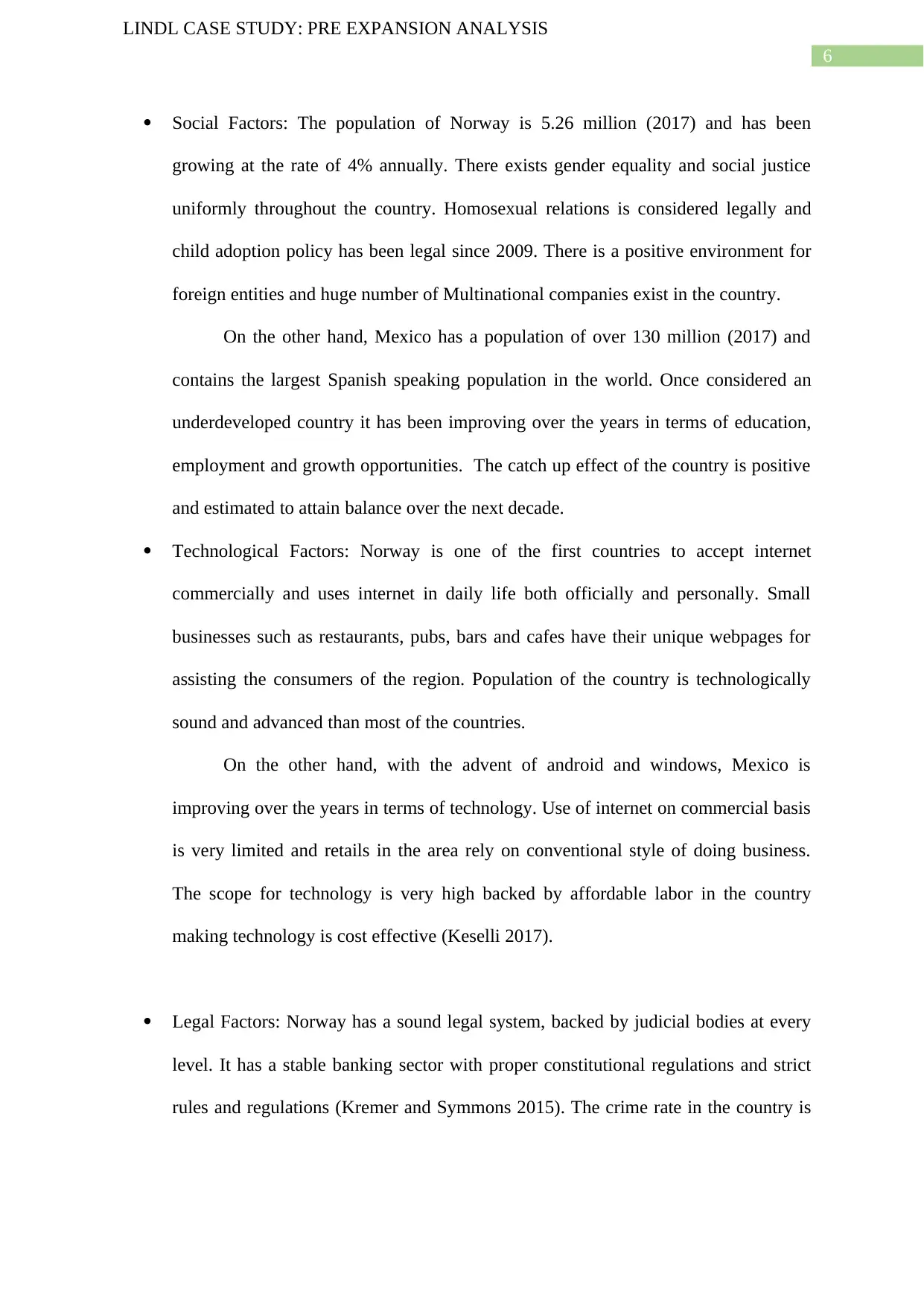
6
LINDL CASE STUDY: PRE EXPANSION ANALYSIS
Social Factors: The population of Norway is 5.26 million (2017) and has been
growing at the rate of 4% annually. There exists gender equality and social justice
uniformly throughout the country. Homosexual relations is considered legally and
child adoption policy has been legal since 2009. There is a positive environment for
foreign entities and huge number of Multinational companies exist in the country.
On the other hand, Mexico has a population of over 130 million (2017) and
contains the largest Spanish speaking population in the world. Once considered an
underdeveloped country it has been improving over the years in terms of education,
employment and growth opportunities. The catch up effect of the country is positive
and estimated to attain balance over the next decade.
Technological Factors: Norway is one of the first countries to accept internet
commercially and uses internet in daily life both officially and personally. Small
businesses such as restaurants, pubs, bars and cafes have their unique webpages for
assisting the consumers of the region. Population of the country is technologically
sound and advanced than most of the countries.
On the other hand, with the advent of android and windows, Mexico is
improving over the years in terms of technology. Use of internet on commercial basis
is very limited and retails in the area rely on conventional style of doing business.
The scope for technology is very high backed by affordable labor in the country
making technology is cost effective (Keselli 2017).
Legal Factors: Norway has a sound legal system, backed by judicial bodies at every
level. It has a stable banking sector with proper constitutional regulations and strict
rules and regulations (Kremer and Symmons 2015). The crime rate in the country is
LINDL CASE STUDY: PRE EXPANSION ANALYSIS
Social Factors: The population of Norway is 5.26 million (2017) and has been
growing at the rate of 4% annually. There exists gender equality and social justice
uniformly throughout the country. Homosexual relations is considered legally and
child adoption policy has been legal since 2009. There is a positive environment for
foreign entities and huge number of Multinational companies exist in the country.
On the other hand, Mexico has a population of over 130 million (2017) and
contains the largest Spanish speaking population in the world. Once considered an
underdeveloped country it has been improving over the years in terms of education,
employment and growth opportunities. The catch up effect of the country is positive
and estimated to attain balance over the next decade.
Technological Factors: Norway is one of the first countries to accept internet
commercially and uses internet in daily life both officially and personally. Small
businesses such as restaurants, pubs, bars and cafes have their unique webpages for
assisting the consumers of the region. Population of the country is technologically
sound and advanced than most of the countries.
On the other hand, with the advent of android and windows, Mexico is
improving over the years in terms of technology. Use of internet on commercial basis
is very limited and retails in the area rely on conventional style of doing business.
The scope for technology is very high backed by affordable labor in the country
making technology is cost effective (Keselli 2017).
Legal Factors: Norway has a sound legal system, backed by judicial bodies at every
level. It has a stable banking sector with proper constitutional regulations and strict
rules and regulations (Kremer and Symmons 2015). The crime rate in the country is
Paraphrase This Document
Need a fresh take? Get an instant paraphrase of this document with our AI Paraphraser
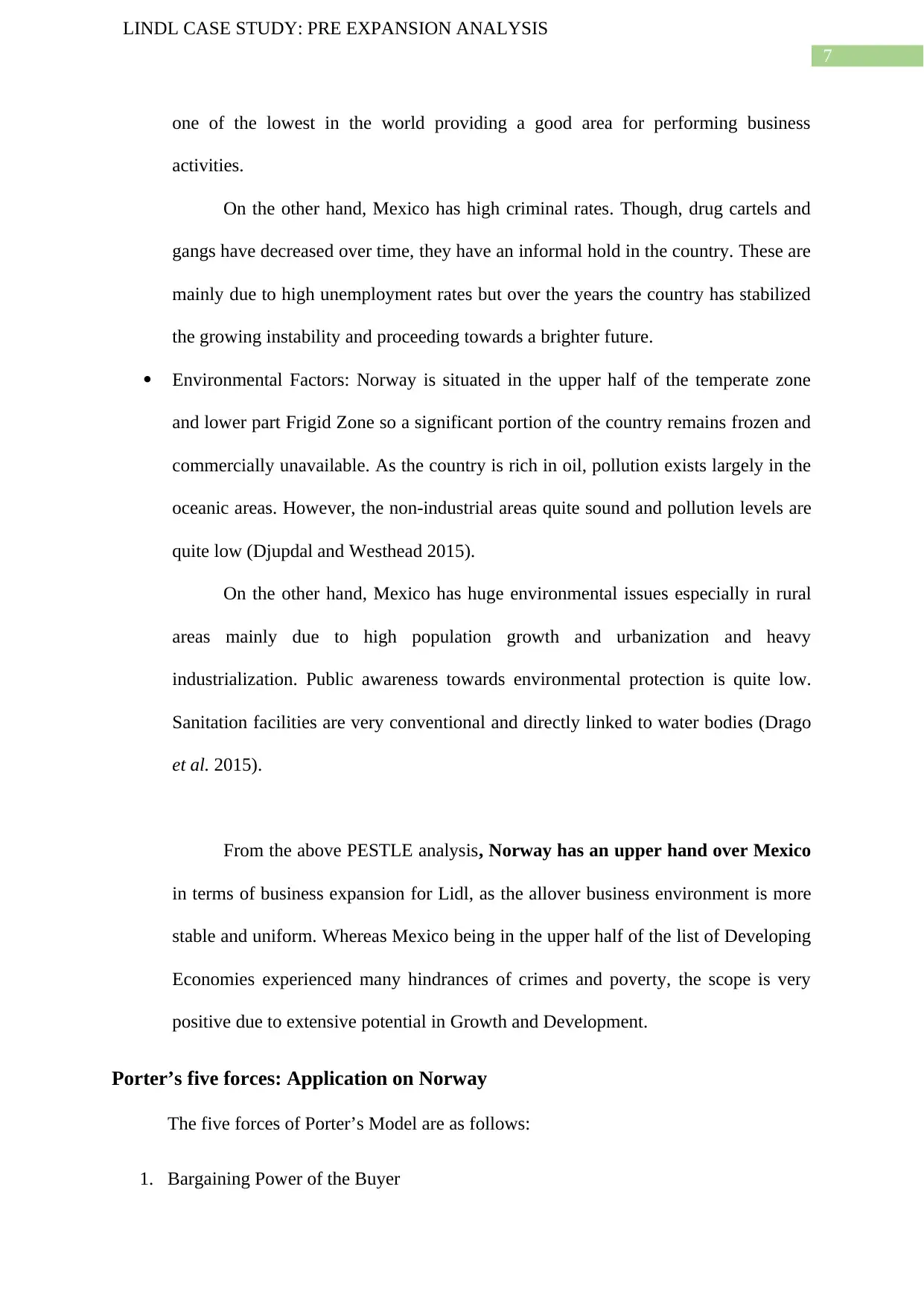
7
LINDL CASE STUDY: PRE EXPANSION ANALYSIS
one of the lowest in the world providing a good area for performing business
activities.
On the other hand, Mexico has high criminal rates. Though, drug cartels and
gangs have decreased over time, they have an informal hold in the country. These are
mainly due to high unemployment rates but over the years the country has stabilized
the growing instability and proceeding towards a brighter future.
Environmental Factors: Norway is situated in the upper half of the temperate zone
and lower part Frigid Zone so a significant portion of the country remains frozen and
commercially unavailable. As the country is rich in oil, pollution exists largely in the
oceanic areas. However, the non-industrial areas quite sound and pollution levels are
quite low (Djupdal and Westhead 2015).
On the other hand, Mexico has huge environmental issues especially in rural
areas mainly due to high population growth and urbanization and heavy
industrialization. Public awareness towards environmental protection is quite low.
Sanitation facilities are very conventional and directly linked to water bodies (Drago
et al. 2015).
From the above PESTLE analysis, Norway has an upper hand over Mexico
in terms of business expansion for Lidl, as the allover business environment is more
stable and uniform. Whereas Mexico being in the upper half of the list of Developing
Economies experienced many hindrances of crimes and poverty, the scope is very
positive due to extensive potential in Growth and Development.
Porter’s five forces: Application on Norway
The five forces of Porter’s Model are as follows:
1. Bargaining Power of the Buyer
LINDL CASE STUDY: PRE EXPANSION ANALYSIS
one of the lowest in the world providing a good area for performing business
activities.
On the other hand, Mexico has high criminal rates. Though, drug cartels and
gangs have decreased over time, they have an informal hold in the country. These are
mainly due to high unemployment rates but over the years the country has stabilized
the growing instability and proceeding towards a brighter future.
Environmental Factors: Norway is situated in the upper half of the temperate zone
and lower part Frigid Zone so a significant portion of the country remains frozen and
commercially unavailable. As the country is rich in oil, pollution exists largely in the
oceanic areas. However, the non-industrial areas quite sound and pollution levels are
quite low (Djupdal and Westhead 2015).
On the other hand, Mexico has huge environmental issues especially in rural
areas mainly due to high population growth and urbanization and heavy
industrialization. Public awareness towards environmental protection is quite low.
Sanitation facilities are very conventional and directly linked to water bodies (Drago
et al. 2015).
From the above PESTLE analysis, Norway has an upper hand over Mexico
in terms of business expansion for Lidl, as the allover business environment is more
stable and uniform. Whereas Mexico being in the upper half of the list of Developing
Economies experienced many hindrances of crimes and poverty, the scope is very
positive due to extensive potential in Growth and Development.
Porter’s five forces: Application on Norway
The five forces of Porter’s Model are as follows:
1. Bargaining Power of the Buyer
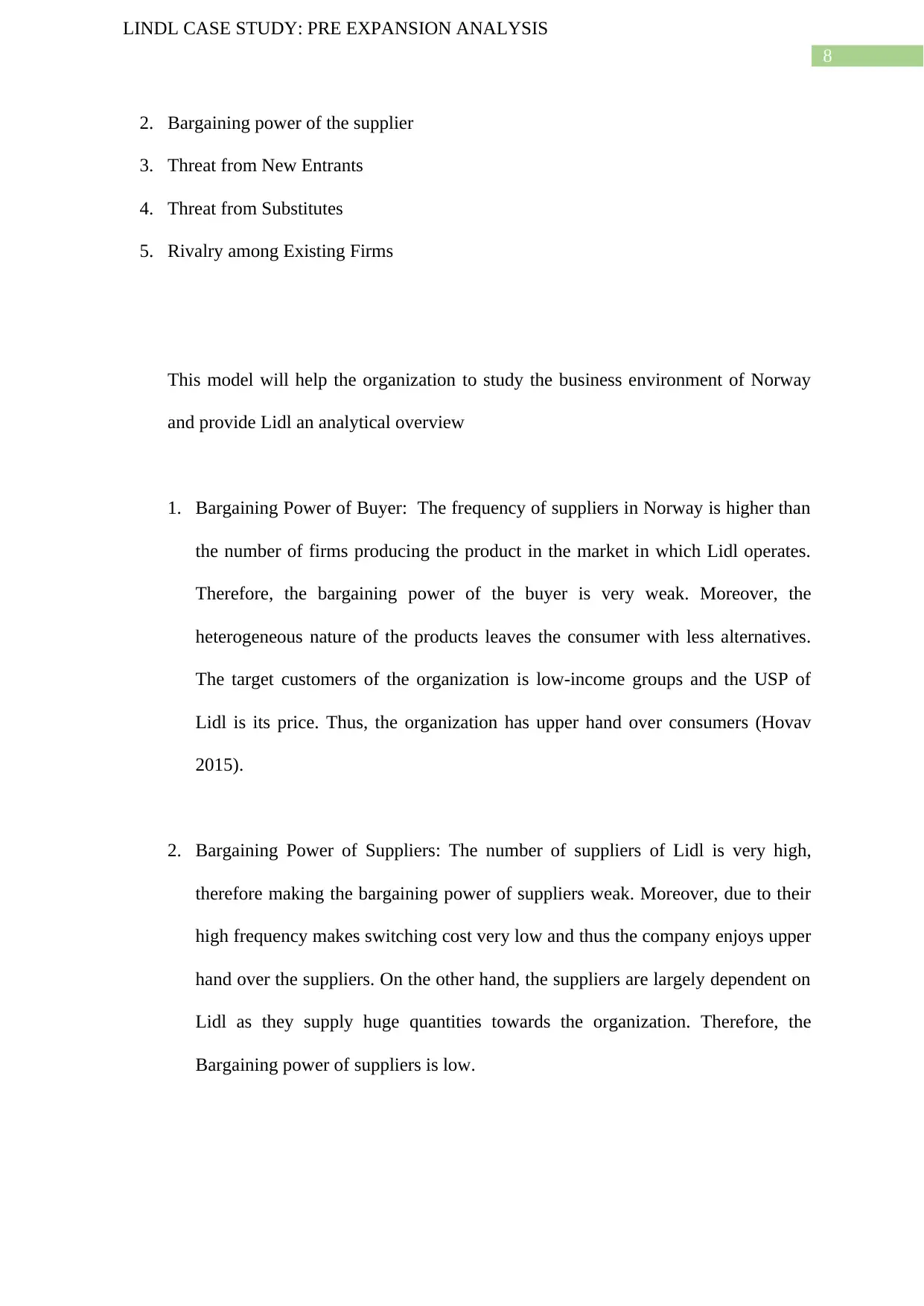
8
LINDL CASE STUDY: PRE EXPANSION ANALYSIS
2. Bargaining power of the supplier
3. Threat from New Entrants
4. Threat from Substitutes
5. Rivalry among Existing Firms
This model will help the organization to study the business environment of Norway
and provide Lidl an analytical overview
1. Bargaining Power of Buyer: The frequency of suppliers in Norway is higher than
the number of firms producing the product in the market in which Lidl operates.
Therefore, the bargaining power of the buyer is very weak. Moreover, the
heterogeneous nature of the products leaves the consumer with less alternatives.
The target customers of the organization is low-income groups and the USP of
Lidl is its price. Thus, the organization has upper hand over consumers (Hovav
2015).
2. Bargaining Power of Suppliers: The number of suppliers of Lidl is very high,
therefore making the bargaining power of suppliers weak. Moreover, due to their
high frequency makes switching cost very low and thus the company enjoys upper
hand over the suppliers. On the other hand, the suppliers are largely dependent on
Lidl as they supply huge quantities towards the organization. Therefore, the
Bargaining power of suppliers is low.
LINDL CASE STUDY: PRE EXPANSION ANALYSIS
2. Bargaining power of the supplier
3. Threat from New Entrants
4. Threat from Substitutes
5. Rivalry among Existing Firms
This model will help the organization to study the business environment of Norway
and provide Lidl an analytical overview
1. Bargaining Power of Buyer: The frequency of suppliers in Norway is higher than
the number of firms producing the product in the market in which Lidl operates.
Therefore, the bargaining power of the buyer is very weak. Moreover, the
heterogeneous nature of the products leaves the consumer with less alternatives.
The target customers of the organization is low-income groups and the USP of
Lidl is its price. Thus, the organization has upper hand over consumers (Hovav
2015).
2. Bargaining Power of Suppliers: The number of suppliers of Lidl is very high,
therefore making the bargaining power of suppliers weak. Moreover, due to their
high frequency makes switching cost very low and thus the company enjoys upper
hand over the suppliers. On the other hand, the suppliers are largely dependent on
Lidl as they supply huge quantities towards the organization. Therefore, the
Bargaining power of suppliers is low.
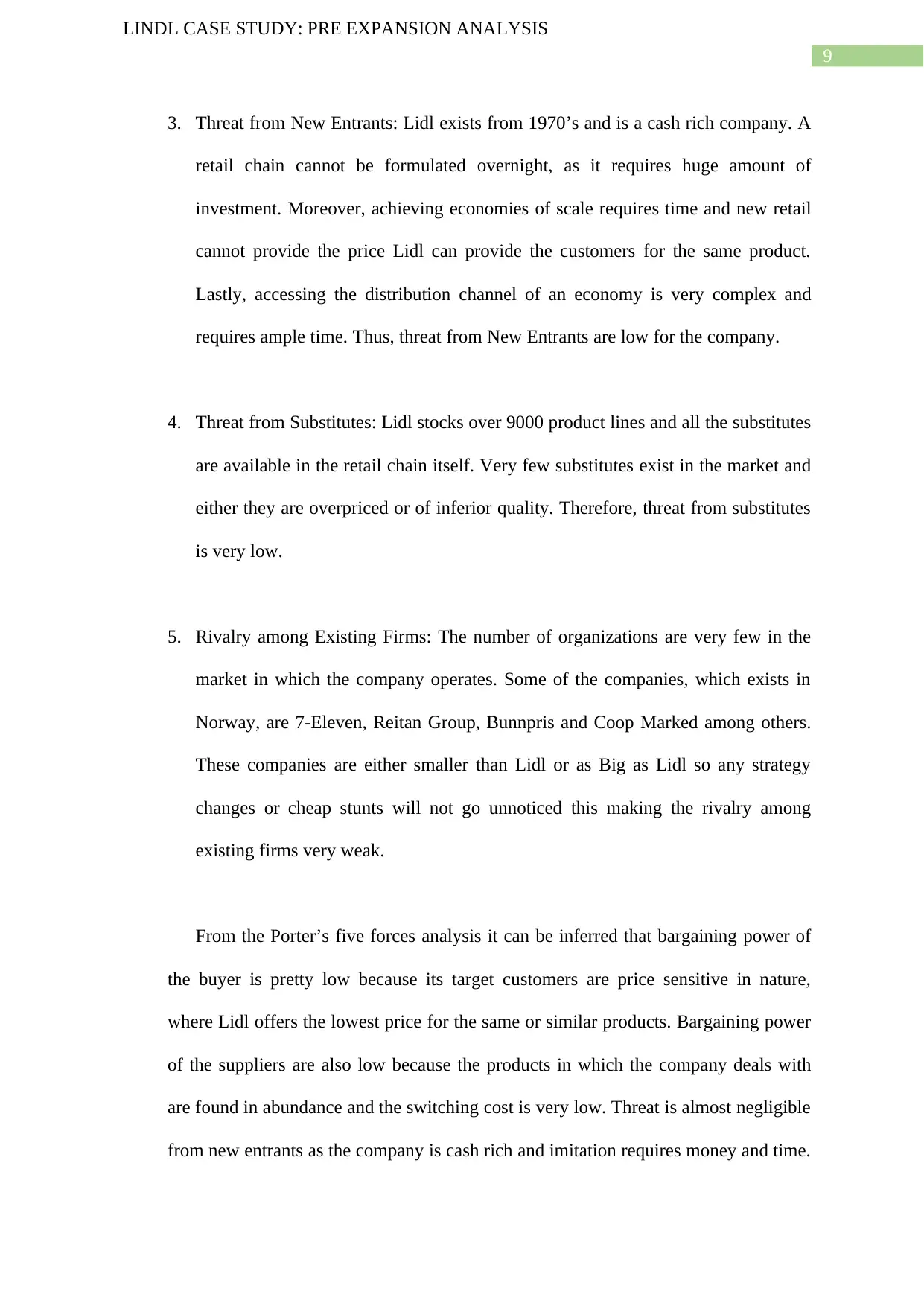
9
LINDL CASE STUDY: PRE EXPANSION ANALYSIS
3. Threat from New Entrants: Lidl exists from 1970’s and is a cash rich company. A
retail chain cannot be formulated overnight, as it requires huge amount of
investment. Moreover, achieving economies of scale requires time and new retail
cannot provide the price Lidl can provide the customers for the same product.
Lastly, accessing the distribution channel of an economy is very complex and
requires ample time. Thus, threat from New Entrants are low for the company.
4. Threat from Substitutes: Lidl stocks over 9000 product lines and all the substitutes
are available in the retail chain itself. Very few substitutes exist in the market and
either they are overpriced or of inferior quality. Therefore, threat from substitutes
is very low.
5. Rivalry among Existing Firms: The number of organizations are very few in the
market in which the company operates. Some of the companies, which exists in
Norway, are 7-Eleven, Reitan Group, Bunnpris and Coop Marked among others.
These companies are either smaller than Lidl or as Big as Lidl so any strategy
changes or cheap stunts will not go unnoticed this making the rivalry among
existing firms very weak.
From the Porter’s five forces analysis it can be inferred that bargaining power of
the buyer is pretty low because its target customers are price sensitive in nature,
where Lidl offers the lowest price for the same or similar products. Bargaining power
of the suppliers are also low because the products in which the company deals with
are found in abundance and the switching cost is very low. Threat is almost negligible
from new entrants as the company is cash rich and imitation requires money and time.
LINDL CASE STUDY: PRE EXPANSION ANALYSIS
3. Threat from New Entrants: Lidl exists from 1970’s and is a cash rich company. A
retail chain cannot be formulated overnight, as it requires huge amount of
investment. Moreover, achieving economies of scale requires time and new retail
cannot provide the price Lidl can provide the customers for the same product.
Lastly, accessing the distribution channel of an economy is very complex and
requires ample time. Thus, threat from New Entrants are low for the company.
4. Threat from Substitutes: Lidl stocks over 9000 product lines and all the substitutes
are available in the retail chain itself. Very few substitutes exist in the market and
either they are overpriced or of inferior quality. Therefore, threat from substitutes
is very low.
5. Rivalry among Existing Firms: The number of organizations are very few in the
market in which the company operates. Some of the companies, which exists in
Norway, are 7-Eleven, Reitan Group, Bunnpris and Coop Marked among others.
These companies are either smaller than Lidl or as Big as Lidl so any strategy
changes or cheap stunts will not go unnoticed this making the rivalry among
existing firms very weak.
From the Porter’s five forces analysis it can be inferred that bargaining power of
the buyer is pretty low because its target customers are price sensitive in nature,
where Lidl offers the lowest price for the same or similar products. Bargaining power
of the suppliers are also low because the products in which the company deals with
are found in abundance and the switching cost is very low. Threat is almost negligible
from new entrants as the company is cash rich and imitation requires money and time.
Secure Best Marks with AI Grader
Need help grading? Try our AI Grader for instant feedback on your assignments.
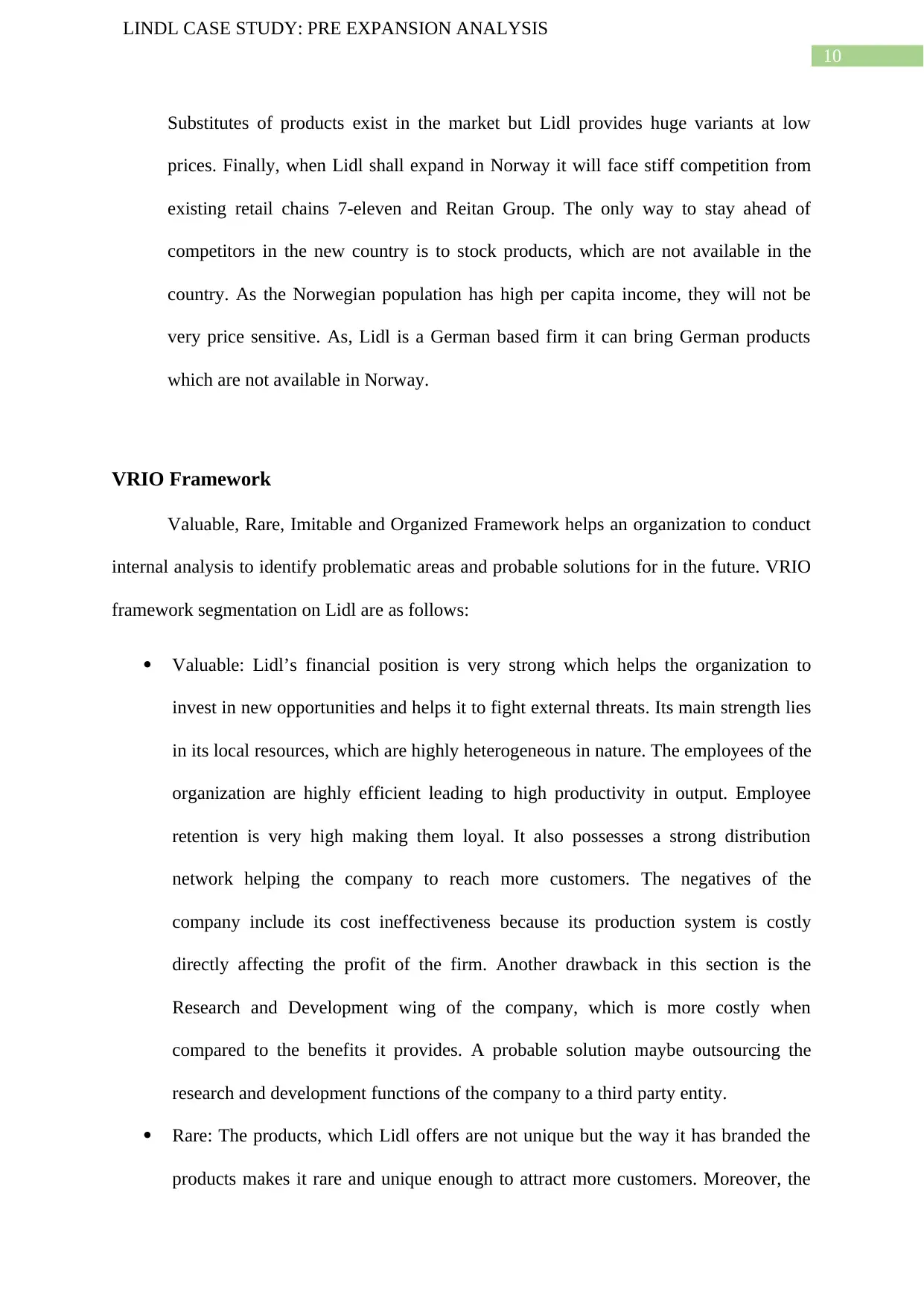
10
LINDL CASE STUDY: PRE EXPANSION ANALYSIS
Substitutes of products exist in the market but Lidl provides huge variants at low
prices. Finally, when Lidl shall expand in Norway it will face stiff competition from
existing retail chains 7-eleven and Reitan Group. The only way to stay ahead of
competitors in the new country is to stock products, which are not available in the
country. As the Norwegian population has high per capita income, they will not be
very price sensitive. As, Lidl is a German based firm it can bring German products
which are not available in Norway.
VRIO Framework
Valuable, Rare, Imitable and Organized Framework helps an organization to conduct
internal analysis to identify problematic areas and probable solutions for in the future. VRIO
framework segmentation on Lidl are as follows:
Valuable: Lidl’s financial position is very strong which helps the organization to
invest in new opportunities and helps it to fight external threats. Its main strength lies
in its local resources, which are highly heterogeneous in nature. The employees of the
organization are highly efficient leading to high productivity in output. Employee
retention is very high making them loyal. It also possesses a strong distribution
network helping the company to reach more customers. The negatives of the
company include its cost ineffectiveness because its production system is costly
directly affecting the profit of the firm. Another drawback in this section is the
Research and Development wing of the company, which is more costly when
compared to the benefits it provides. A probable solution maybe outsourcing the
research and development functions of the company to a third party entity.
Rare: The products, which Lidl offers are not unique but the way it has branded the
products makes it rare and unique enough to attract more customers. Moreover, the
LINDL CASE STUDY: PRE EXPANSION ANALYSIS
Substitutes of products exist in the market but Lidl provides huge variants at low
prices. Finally, when Lidl shall expand in Norway it will face stiff competition from
existing retail chains 7-eleven and Reitan Group. The only way to stay ahead of
competitors in the new country is to stock products, which are not available in the
country. As the Norwegian population has high per capita income, they will not be
very price sensitive. As, Lidl is a German based firm it can bring German products
which are not available in Norway.
VRIO Framework
Valuable, Rare, Imitable and Organized Framework helps an organization to conduct
internal analysis to identify problematic areas and probable solutions for in the future. VRIO
framework segmentation on Lidl are as follows:
Valuable: Lidl’s financial position is very strong which helps the organization to
invest in new opportunities and helps it to fight external threats. Its main strength lies
in its local resources, which are highly heterogeneous in nature. The employees of the
organization are highly efficient leading to high productivity in output. Employee
retention is very high making them loyal. It also possesses a strong distribution
network helping the company to reach more customers. The negatives of the
company include its cost ineffectiveness because its production system is costly
directly affecting the profit of the firm. Another drawback in this section is the
Research and Development wing of the company, which is more costly when
compared to the benefits it provides. A probable solution maybe outsourcing the
research and development functions of the company to a third party entity.
Rare: The products, which Lidl offers are not unique but the way it has branded the
products makes it rare and unique enough to attract more customers. Moreover, the
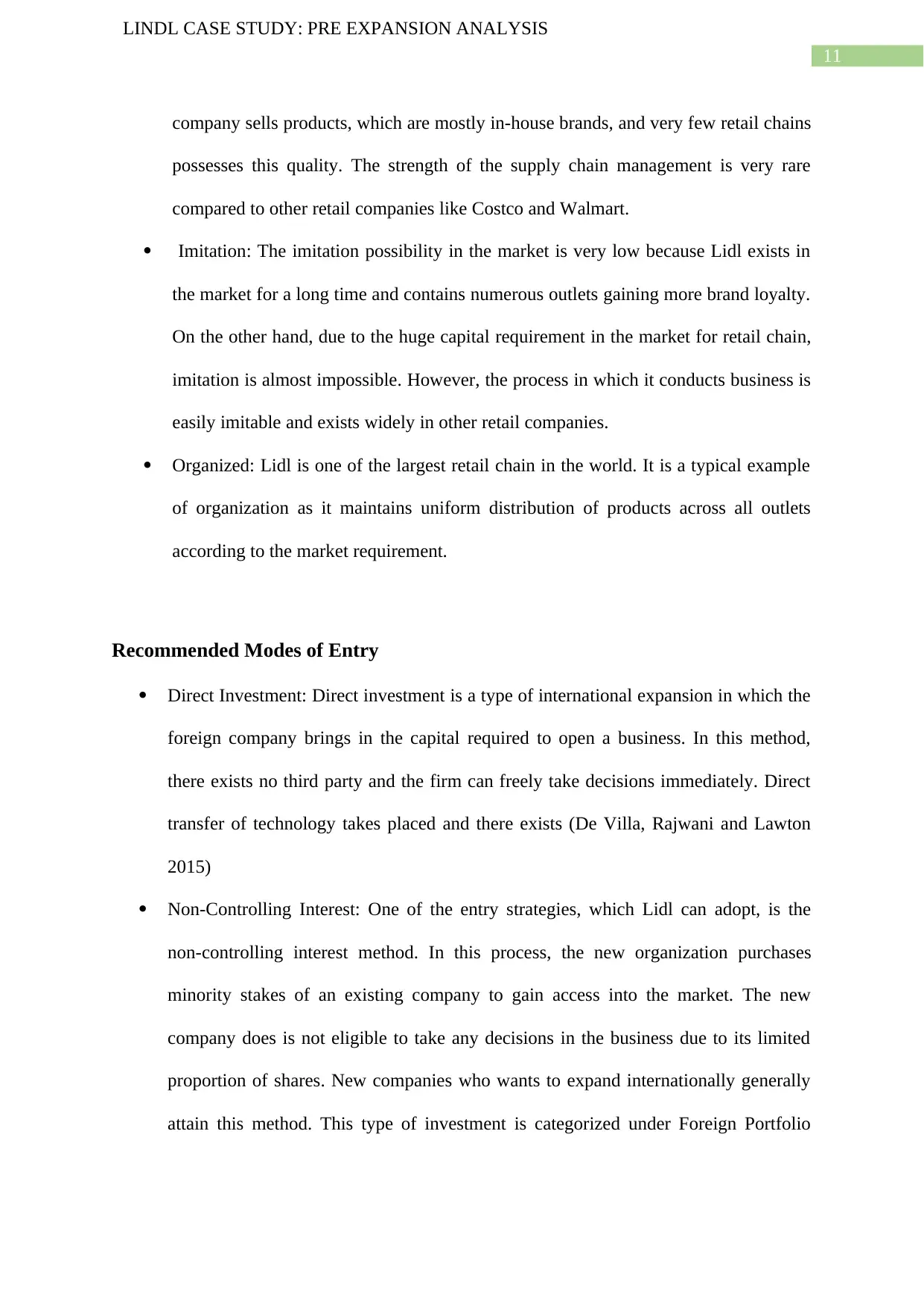
11
LINDL CASE STUDY: PRE EXPANSION ANALYSIS
company sells products, which are mostly in-house brands, and very few retail chains
possesses this quality. The strength of the supply chain management is very rare
compared to other retail companies like Costco and Walmart.
Imitation: The imitation possibility in the market is very low because Lidl exists in
the market for a long time and contains numerous outlets gaining more brand loyalty.
On the other hand, due to the huge capital requirement in the market for retail chain,
imitation is almost impossible. However, the process in which it conducts business is
easily imitable and exists widely in other retail companies.
Organized: Lidl is one of the largest retail chain in the world. It is a typical example
of organization as it maintains uniform distribution of products across all outlets
according to the market requirement.
Recommended Modes of Entry
Direct Investment: Direct investment is a type of international expansion in which the
foreign company brings in the capital required to open a business. In this method,
there exists no third party and the firm can freely take decisions immediately. Direct
transfer of technology takes placed and there exists (De Villa, Rajwani and Lawton
2015)
Non-Controlling Interest: One of the entry strategies, which Lidl can adopt, is the
non-controlling interest method. In this process, the new organization purchases
minority stakes of an existing company to gain access into the market. The new
company does is not eligible to take any decisions in the business due to its limited
proportion of shares. New companies who wants to expand internationally generally
attain this method. This type of investment is categorized under Foreign Portfolio
LINDL CASE STUDY: PRE EXPANSION ANALYSIS
company sells products, which are mostly in-house brands, and very few retail chains
possesses this quality. The strength of the supply chain management is very rare
compared to other retail companies like Costco and Walmart.
Imitation: The imitation possibility in the market is very low because Lidl exists in
the market for a long time and contains numerous outlets gaining more brand loyalty.
On the other hand, due to the huge capital requirement in the market for retail chain,
imitation is almost impossible. However, the process in which it conducts business is
easily imitable and exists widely in other retail companies.
Organized: Lidl is one of the largest retail chain in the world. It is a typical example
of organization as it maintains uniform distribution of products across all outlets
according to the market requirement.
Recommended Modes of Entry
Direct Investment: Direct investment is a type of international expansion in which the
foreign company brings in the capital required to open a business. In this method,
there exists no third party and the firm can freely take decisions immediately. Direct
transfer of technology takes placed and there exists (De Villa, Rajwani and Lawton
2015)
Non-Controlling Interest: One of the entry strategies, which Lidl can adopt, is the
non-controlling interest method. In this process, the new organization purchases
minority stakes of an existing company to gain access into the market. The new
company does is not eligible to take any decisions in the business due to its limited
proportion of shares. New companies who wants to expand internationally generally
attain this method. This type of investment is categorized under Foreign Portfolio
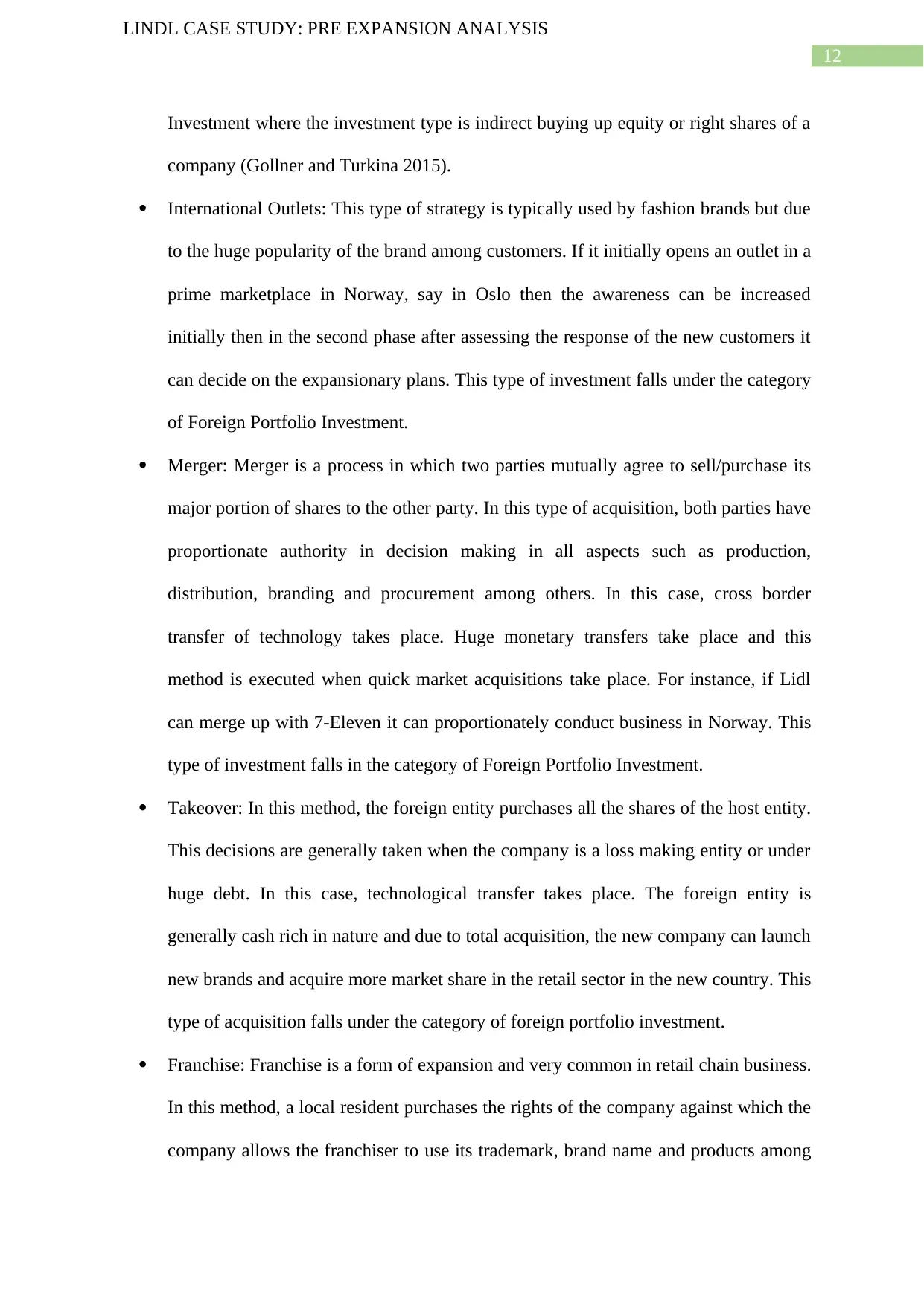
12
LINDL CASE STUDY: PRE EXPANSION ANALYSIS
Investment where the investment type is indirect buying up equity or right shares of a
company (Gollner and Turkina 2015).
International Outlets: This type of strategy is typically used by fashion brands but due
to the huge popularity of the brand among customers. If it initially opens an outlet in a
prime marketplace in Norway, say in Oslo then the awareness can be increased
initially then in the second phase after assessing the response of the new customers it
can decide on the expansionary plans. This type of investment falls under the category
of Foreign Portfolio Investment.
Merger: Merger is a process in which two parties mutually agree to sell/purchase its
major portion of shares to the other party. In this type of acquisition, both parties have
proportionate authority in decision making in all aspects such as production,
distribution, branding and procurement among others. In this case, cross border
transfer of technology takes place. Huge monetary transfers take place and this
method is executed when quick market acquisitions take place. For instance, if Lidl
can merge up with 7-Eleven it can proportionately conduct business in Norway. This
type of investment falls in the category of Foreign Portfolio Investment.
Takeover: In this method, the foreign entity purchases all the shares of the host entity.
This decisions are generally taken when the company is a loss making entity or under
huge debt. In this case, technological transfer takes place. The foreign entity is
generally cash rich in nature and due to total acquisition, the new company can launch
new brands and acquire more market share in the retail sector in the new country. This
type of acquisition falls under the category of foreign portfolio investment.
Franchise: Franchise is a form of expansion and very common in retail chain business.
In this method, a local resident purchases the rights of the company against which the
company allows the franchiser to use its trademark, brand name and products among
LINDL CASE STUDY: PRE EXPANSION ANALYSIS
Investment where the investment type is indirect buying up equity or right shares of a
company (Gollner and Turkina 2015).
International Outlets: This type of strategy is typically used by fashion brands but due
to the huge popularity of the brand among customers. If it initially opens an outlet in a
prime marketplace in Norway, say in Oslo then the awareness can be increased
initially then in the second phase after assessing the response of the new customers it
can decide on the expansionary plans. This type of investment falls under the category
of Foreign Portfolio Investment.
Merger: Merger is a process in which two parties mutually agree to sell/purchase its
major portion of shares to the other party. In this type of acquisition, both parties have
proportionate authority in decision making in all aspects such as production,
distribution, branding and procurement among others. In this case, cross border
transfer of technology takes place. Huge monetary transfers take place and this
method is executed when quick market acquisitions take place. For instance, if Lidl
can merge up with 7-Eleven it can proportionately conduct business in Norway. This
type of investment falls in the category of Foreign Portfolio Investment.
Takeover: In this method, the foreign entity purchases all the shares of the host entity.
This decisions are generally taken when the company is a loss making entity or under
huge debt. In this case, technological transfer takes place. The foreign entity is
generally cash rich in nature and due to total acquisition, the new company can launch
new brands and acquire more market share in the retail sector in the new country. This
type of acquisition falls under the category of foreign portfolio investment.
Franchise: Franchise is a form of expansion and very common in retail chain business.
In this method, a local resident purchases the rights of the company against which the
company allows the franchiser to use its trademark, brand name and products among
Paraphrase This Document
Need a fresh take? Get an instant paraphrase of this document with our AI Paraphraser
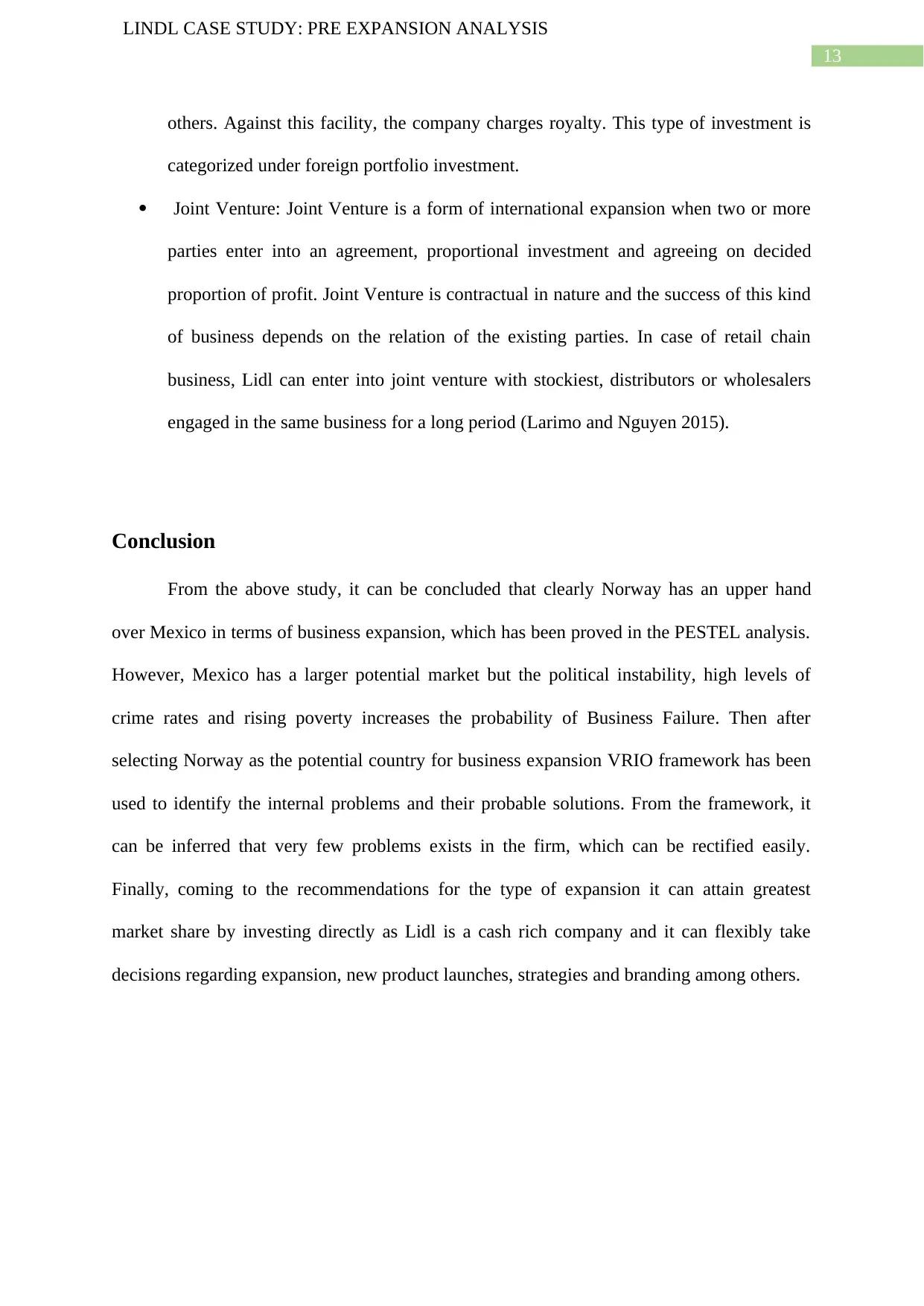
13
LINDL CASE STUDY: PRE EXPANSION ANALYSIS
others. Against this facility, the company charges royalty. This type of investment is
categorized under foreign portfolio investment.
Joint Venture: Joint Venture is a form of international expansion when two or more
parties enter into an agreement, proportional investment and agreeing on decided
proportion of profit. Joint Venture is contractual in nature and the success of this kind
of business depends on the relation of the existing parties. In case of retail chain
business, Lidl can enter into joint venture with stockiest, distributors or wholesalers
engaged in the same business for a long period (Larimo and Nguyen 2015).
Conclusion
From the above study, it can be concluded that clearly Norway has an upper hand
over Mexico in terms of business expansion, which has been proved in the PESTEL analysis.
However, Mexico has a larger potential market but the political instability, high levels of
crime rates and rising poverty increases the probability of Business Failure. Then after
selecting Norway as the potential country for business expansion VRIO framework has been
used to identify the internal problems and their probable solutions. From the framework, it
can be inferred that very few problems exists in the firm, which can be rectified easily.
Finally, coming to the recommendations for the type of expansion it can attain greatest
market share by investing directly as Lidl is a cash rich company and it can flexibly take
decisions regarding expansion, new product launches, strategies and branding among others.
LINDL CASE STUDY: PRE EXPANSION ANALYSIS
others. Against this facility, the company charges royalty. This type of investment is
categorized under foreign portfolio investment.
Joint Venture: Joint Venture is a form of international expansion when two or more
parties enter into an agreement, proportional investment and agreeing on decided
proportion of profit. Joint Venture is contractual in nature and the success of this kind
of business depends on the relation of the existing parties. In case of retail chain
business, Lidl can enter into joint venture with stockiest, distributors or wholesalers
engaged in the same business for a long period (Larimo and Nguyen 2015).
Conclusion
From the above study, it can be concluded that clearly Norway has an upper hand
over Mexico in terms of business expansion, which has been proved in the PESTEL analysis.
However, Mexico has a larger potential market but the political instability, high levels of
crime rates and rising poverty increases the probability of Business Failure. Then after
selecting Norway as the potential country for business expansion VRIO framework has been
used to identify the internal problems and their probable solutions. From the framework, it
can be inferred that very few problems exists in the firm, which can be rectified easily.
Finally, coming to the recommendations for the type of expansion it can attain greatest
market share by investing directly as Lidl is a cash rich company and it can flexibly take
decisions regarding expansion, new product launches, strategies and branding among others.
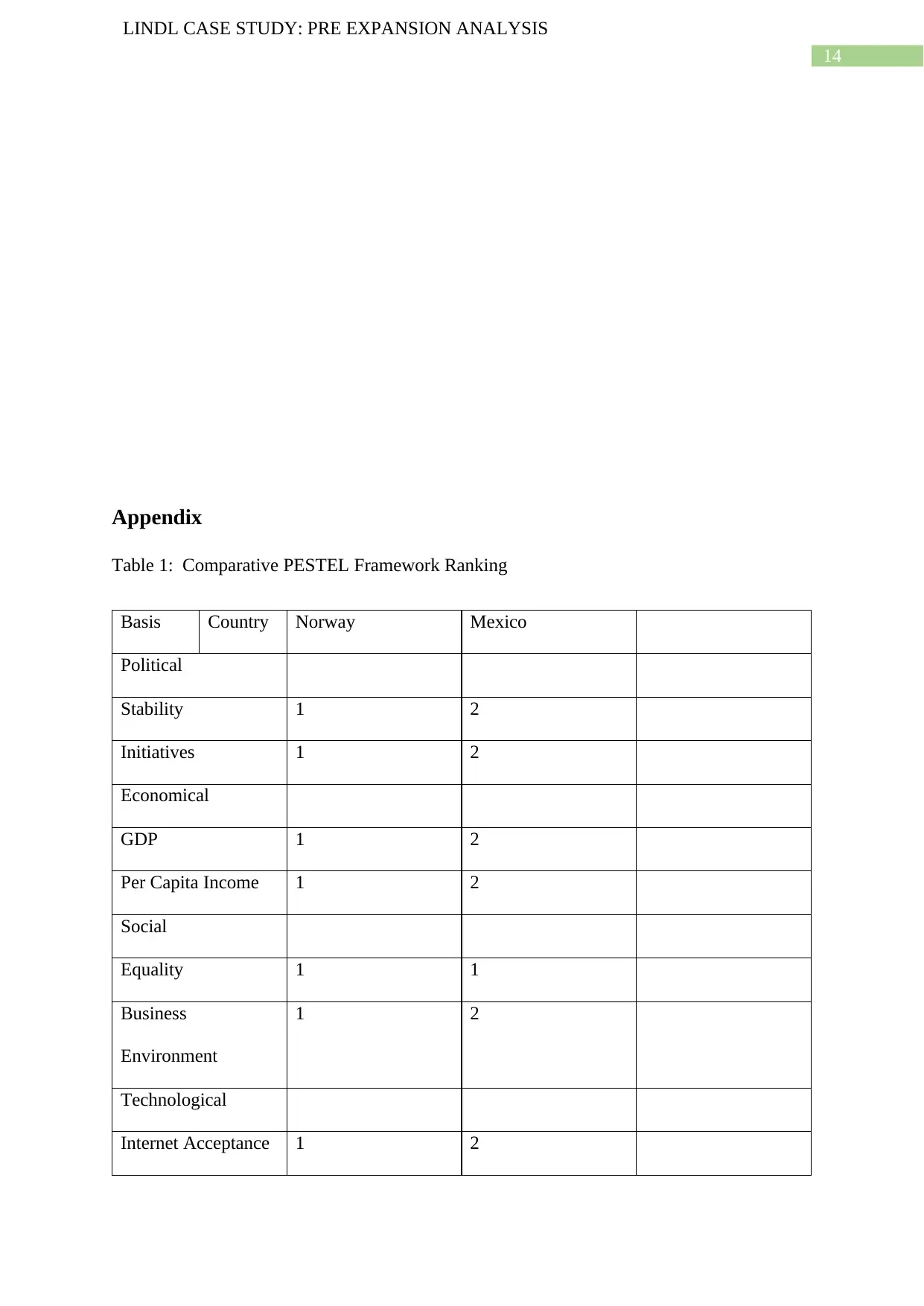
14
LINDL CASE STUDY: PRE EXPANSION ANALYSIS
Appendix
Table 1: Comparative PESTEL Framework Ranking
Basis Country Norway Mexico
Political
Stability 1 2
Initiatives 1 2
Economical
GDP 1 2
Per Capita Income 1 2
Social
Equality 1 1
Business
Environment
1 2
Technological
Internet Acceptance 1 2
LINDL CASE STUDY: PRE EXPANSION ANALYSIS
Appendix
Table 1: Comparative PESTEL Framework Ranking
Basis Country Norway Mexico
Political
Stability 1 2
Initiatives 1 2
Economical
GDP 1 2
Per Capita Income 1 2
Social
Equality 1 1
Business
Environment
1 2
Technological
Internet Acceptance 1 2
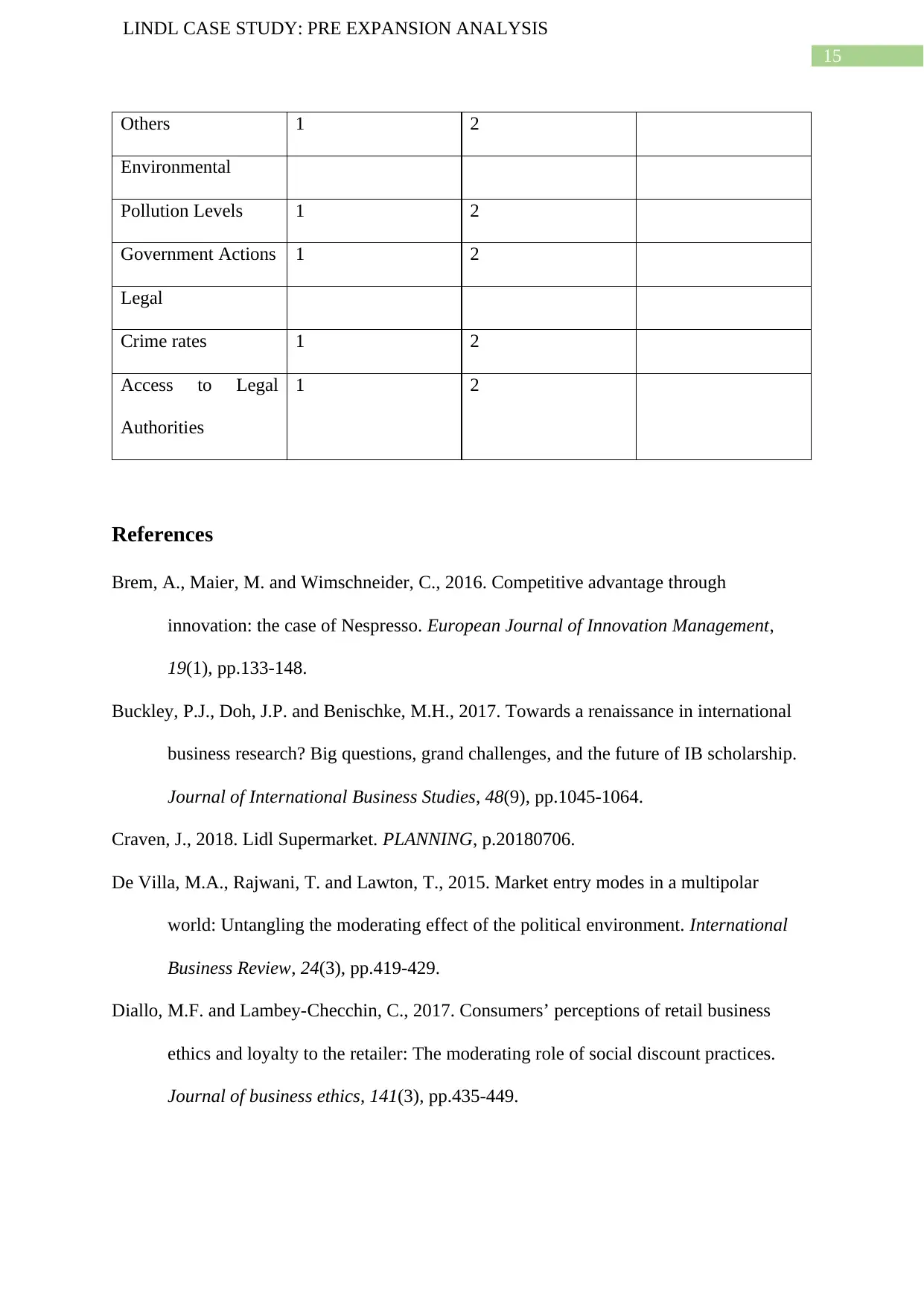
15
LINDL CASE STUDY: PRE EXPANSION ANALYSIS
Others 1 2
Environmental
Pollution Levels 1 2
Government Actions 1 2
Legal
Crime rates 1 2
Access to Legal
Authorities
1 2
References
Brem, A., Maier, M. and Wimschneider, C., 2016. Competitive advantage through
innovation: the case of Nespresso. European Journal of Innovation Management,
19(1), pp.133-148.
Buckley, P.J., Doh, J.P. and Benischke, M.H., 2017. Towards a renaissance in international
business research? Big questions, grand challenges, and the future of IB scholarship.
Journal of International Business Studies, 48(9), pp.1045-1064.
Craven, J., 2018. Lidl Supermarket. PLANNING, p.20180706.
De Villa, M.A., Rajwani, T. and Lawton, T., 2015. Market entry modes in a multipolar
world: Untangling the moderating effect of the political environment. International
Business Review, 24(3), pp.419-429.
Diallo, M.F. and Lambey-Checchin, C., 2017. Consumers’ perceptions of retail business
ethics and loyalty to the retailer: The moderating role of social discount practices.
Journal of business ethics, 141(3), pp.435-449.
LINDL CASE STUDY: PRE EXPANSION ANALYSIS
Others 1 2
Environmental
Pollution Levels 1 2
Government Actions 1 2
Legal
Crime rates 1 2
Access to Legal
Authorities
1 2
References
Brem, A., Maier, M. and Wimschneider, C., 2016. Competitive advantage through
innovation: the case of Nespresso. European Journal of Innovation Management,
19(1), pp.133-148.
Buckley, P.J., Doh, J.P. and Benischke, M.H., 2017. Towards a renaissance in international
business research? Big questions, grand challenges, and the future of IB scholarship.
Journal of International Business Studies, 48(9), pp.1045-1064.
Craven, J., 2018. Lidl Supermarket. PLANNING, p.20180706.
De Villa, M.A., Rajwani, T. and Lawton, T., 2015. Market entry modes in a multipolar
world: Untangling the moderating effect of the political environment. International
Business Review, 24(3), pp.419-429.
Diallo, M.F. and Lambey-Checchin, C., 2017. Consumers’ perceptions of retail business
ethics and loyalty to the retailer: The moderating role of social discount practices.
Journal of business ethics, 141(3), pp.435-449.
Secure Best Marks with AI Grader
Need help grading? Try our AI Grader for instant feedback on your assignments.
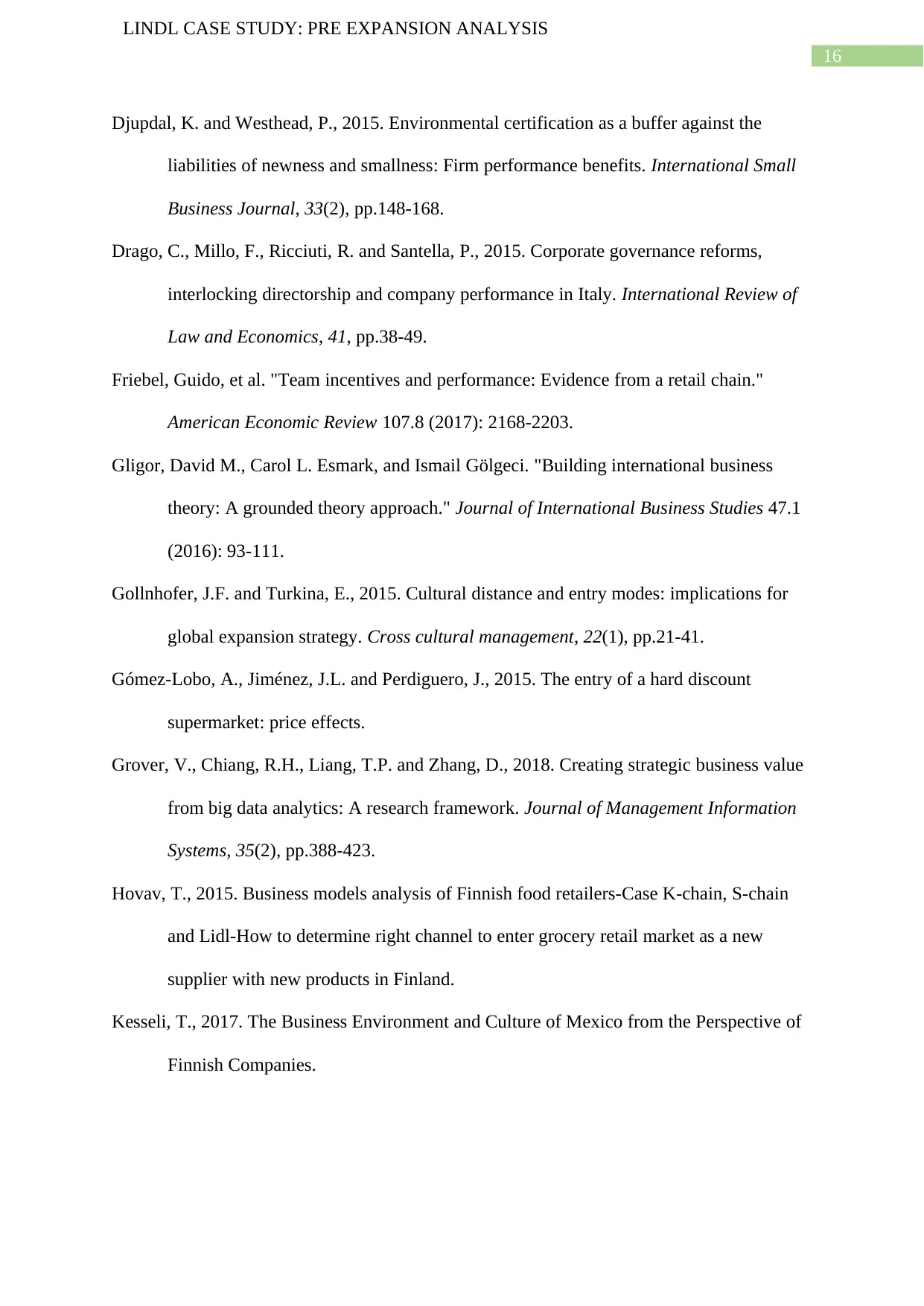
16
LINDL CASE STUDY: PRE EXPANSION ANALYSIS
Djupdal, K. and Westhead, P., 2015. Environmental certification as a buffer against the
liabilities of newness and smallness: Firm performance benefits. International Small
Business Journal, 33(2), pp.148-168.
Drago, C., Millo, F., Ricciuti, R. and Santella, P., 2015. Corporate governance reforms,
interlocking directorship and company performance in Italy. International Review of
Law and Economics, 41, pp.38-49.
Friebel, Guido, et al. "Team incentives and performance: Evidence from a retail chain."
American Economic Review 107.8 (2017): 2168-2203.
Gligor, David M., Carol L. Esmark, and Ismail Gölgeci. "Building international business
theory: A grounded theory approach." Journal of International Business Studies 47.1
(2016): 93-111.
Gollnhofer, J.F. and Turkina, E., 2015. Cultural distance and entry modes: implications for
global expansion strategy. Cross cultural management, 22(1), pp.21-41.
Gómez-Lobo, A., Jiménez, J.L. and Perdiguero, J., 2015. The entry of a hard discount
supermarket: price effects.
Grover, V., Chiang, R.H., Liang, T.P. and Zhang, D., 2018. Creating strategic business value
from big data analytics: A research framework. Journal of Management Information
Systems, 35(2), pp.388-423.
Hovav, T., 2015. Business models analysis of Finnish food retailers-Case K-chain, S-chain
and Lidl-How to determine right channel to enter grocery retail market as a new
supplier with new products in Finland.
Kesseli, T., 2017. The Business Environment and Culture of Mexico from the Perspective of
Finnish Companies.
LINDL CASE STUDY: PRE EXPANSION ANALYSIS
Djupdal, K. and Westhead, P., 2015. Environmental certification as a buffer against the
liabilities of newness and smallness: Firm performance benefits. International Small
Business Journal, 33(2), pp.148-168.
Drago, C., Millo, F., Ricciuti, R. and Santella, P., 2015. Corporate governance reforms,
interlocking directorship and company performance in Italy. International Review of
Law and Economics, 41, pp.38-49.
Friebel, Guido, et al. "Team incentives and performance: Evidence from a retail chain."
American Economic Review 107.8 (2017): 2168-2203.
Gligor, David M., Carol L. Esmark, and Ismail Gölgeci. "Building international business
theory: A grounded theory approach." Journal of International Business Studies 47.1
(2016): 93-111.
Gollnhofer, J.F. and Turkina, E., 2015. Cultural distance and entry modes: implications for
global expansion strategy. Cross cultural management, 22(1), pp.21-41.
Gómez-Lobo, A., Jiménez, J.L. and Perdiguero, J., 2015. The entry of a hard discount
supermarket: price effects.
Grover, V., Chiang, R.H., Liang, T.P. and Zhang, D., 2018. Creating strategic business value
from big data analytics: A research framework. Journal of Management Information
Systems, 35(2), pp.388-423.
Hovav, T., 2015. Business models analysis of Finnish food retailers-Case K-chain, S-chain
and Lidl-How to determine right channel to enter grocery retail market as a new
supplier with new products in Finland.
Kesseli, T., 2017. The Business Environment and Culture of Mexico from the Perspective of
Finnish Companies.
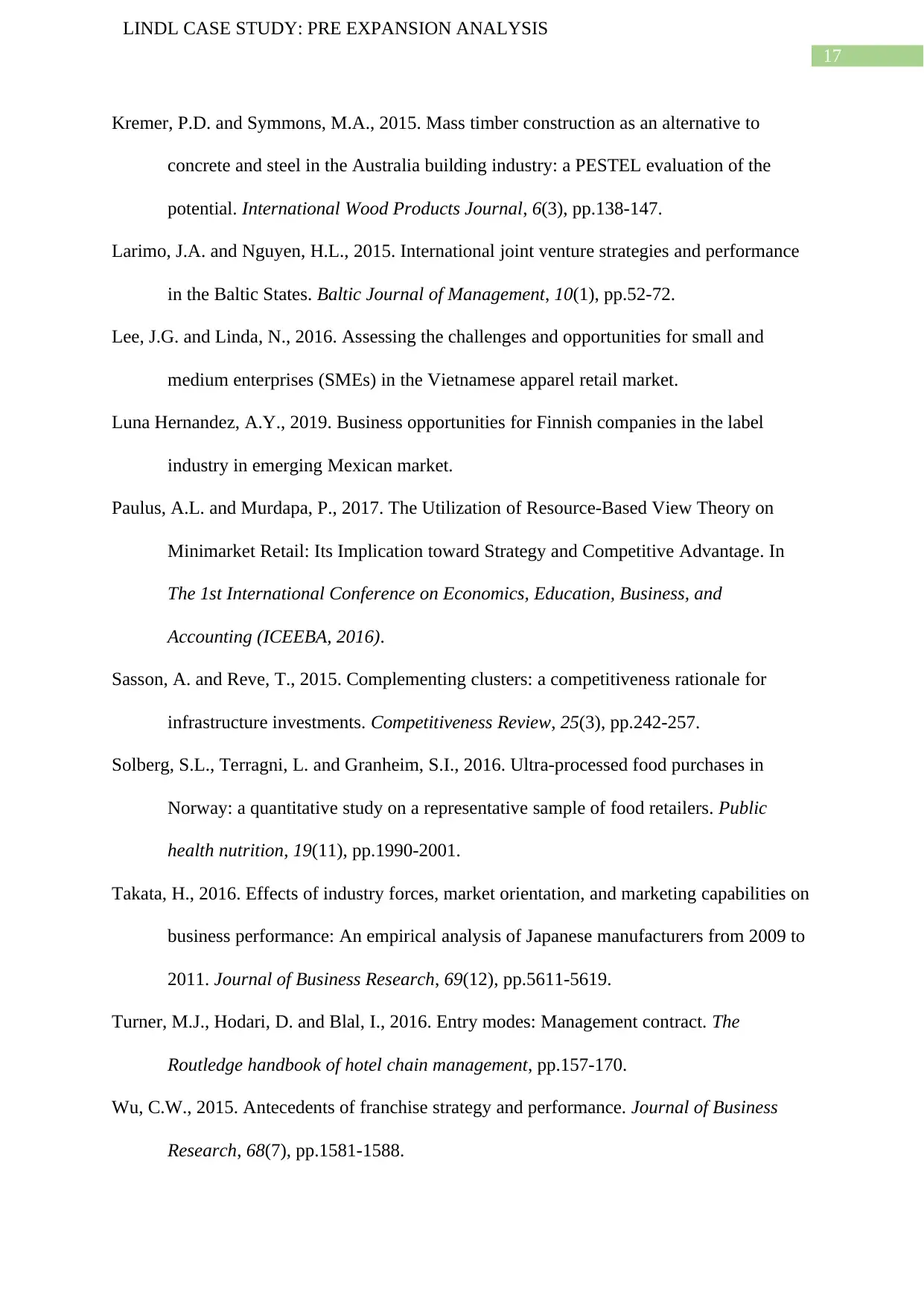
17
LINDL CASE STUDY: PRE EXPANSION ANALYSIS
Kremer, P.D. and Symmons, M.A., 2015. Mass timber construction as an alternative to
concrete and steel in the Australia building industry: a PESTEL evaluation of the
potential. International Wood Products Journal, 6(3), pp.138-147.
Larimo, J.A. and Nguyen, H.L., 2015. International joint venture strategies and performance
in the Baltic States. Baltic Journal of Management, 10(1), pp.52-72.
Lee, J.G. and Linda, N., 2016. Assessing the challenges and opportunities for small and
medium enterprises (SMEs) in the Vietnamese apparel retail market.
Luna Hernandez, A.Y., 2019. Business opportunities for Finnish companies in the label
industry in emerging Mexican market.
Paulus, A.L. and Murdapa, P., 2017. The Utilization of Resource-Based View Theory on
Minimarket Retail: Its Implication toward Strategy and Competitive Advantage. In
The 1st International Conference on Economics, Education, Business, and
Accounting (ICEEBA, 2016).
Sasson, A. and Reve, T., 2015. Complementing clusters: a competitiveness rationale for
infrastructure investments. Competitiveness Review, 25(3), pp.242-257.
Solberg, S.L., Terragni, L. and Granheim, S.I., 2016. Ultra-processed food purchases in
Norway: a quantitative study on a representative sample of food retailers. Public
health nutrition, 19(11), pp.1990-2001.
Takata, H., 2016. Effects of industry forces, market orientation, and marketing capabilities on
business performance: An empirical analysis of Japanese manufacturers from 2009 to
2011. Journal of Business Research, 69(12), pp.5611-5619.
Turner, M.J., Hodari, D. and Blal, I., 2016. Entry modes: Management contract. The
Routledge handbook of hotel chain management, pp.157-170.
Wu, C.W., 2015. Antecedents of franchise strategy and performance. Journal of Business
Research, 68(7), pp.1581-1588.
LINDL CASE STUDY: PRE EXPANSION ANALYSIS
Kremer, P.D. and Symmons, M.A., 2015. Mass timber construction as an alternative to
concrete and steel in the Australia building industry: a PESTEL evaluation of the
potential. International Wood Products Journal, 6(3), pp.138-147.
Larimo, J.A. and Nguyen, H.L., 2015. International joint venture strategies and performance
in the Baltic States. Baltic Journal of Management, 10(1), pp.52-72.
Lee, J.G. and Linda, N., 2016. Assessing the challenges and opportunities for small and
medium enterprises (SMEs) in the Vietnamese apparel retail market.
Luna Hernandez, A.Y., 2019. Business opportunities for Finnish companies in the label
industry in emerging Mexican market.
Paulus, A.L. and Murdapa, P., 2017. The Utilization of Resource-Based View Theory on
Minimarket Retail: Its Implication toward Strategy and Competitive Advantage. In
The 1st International Conference on Economics, Education, Business, and
Accounting (ICEEBA, 2016).
Sasson, A. and Reve, T., 2015. Complementing clusters: a competitiveness rationale for
infrastructure investments. Competitiveness Review, 25(3), pp.242-257.
Solberg, S.L., Terragni, L. and Granheim, S.I., 2016. Ultra-processed food purchases in
Norway: a quantitative study on a representative sample of food retailers. Public
health nutrition, 19(11), pp.1990-2001.
Takata, H., 2016. Effects of industry forces, market orientation, and marketing capabilities on
business performance: An empirical analysis of Japanese manufacturers from 2009 to
2011. Journal of Business Research, 69(12), pp.5611-5619.
Turner, M.J., Hodari, D. and Blal, I., 2016. Entry modes: Management contract. The
Routledge handbook of hotel chain management, pp.157-170.
Wu, C.W., 2015. Antecedents of franchise strategy and performance. Journal of Business
Research, 68(7), pp.1581-1588.

18
LINDL CASE STUDY: PRE EXPANSION ANALYSIS
LINDL CASE STUDY: PRE EXPANSION ANALYSIS
1 out of 19
Related Documents
Your All-in-One AI-Powered Toolkit for Academic Success.
+13062052269
info@desklib.com
Available 24*7 on WhatsApp / Email
![[object Object]](/_next/static/media/star-bottom.7253800d.svg)
Unlock your academic potential
© 2024 | Zucol Services PVT LTD | All rights reserved.





